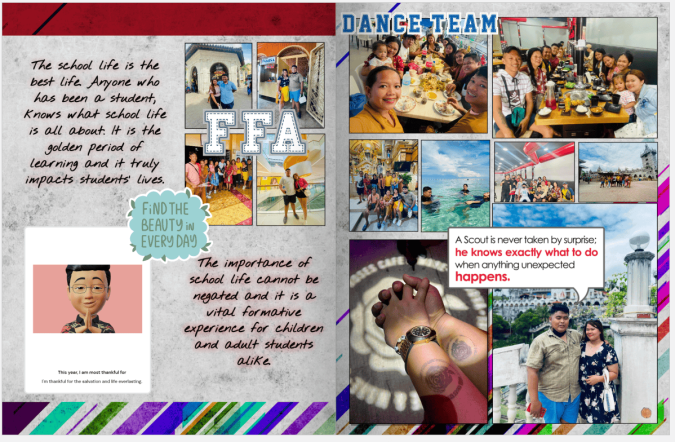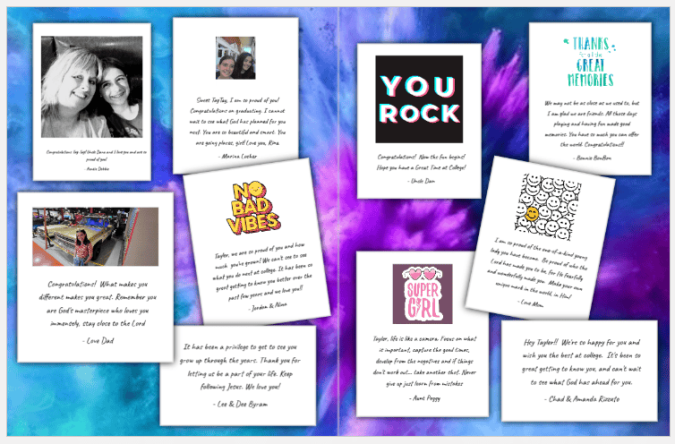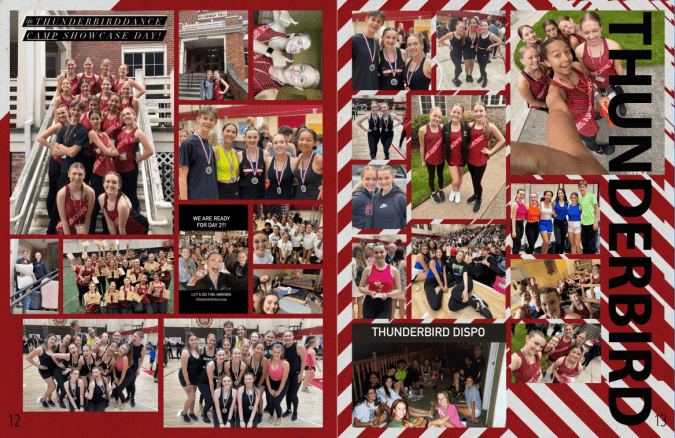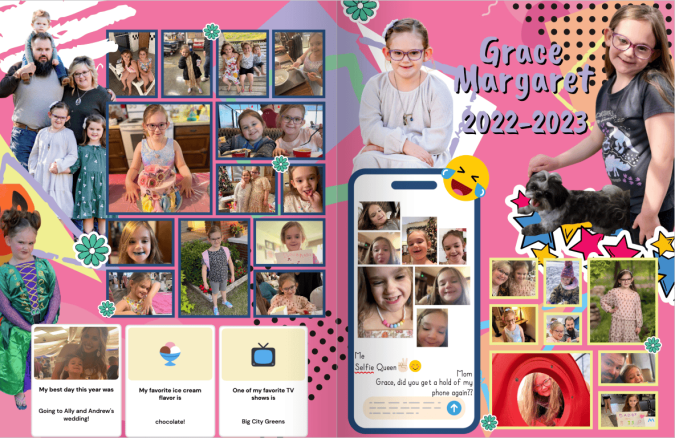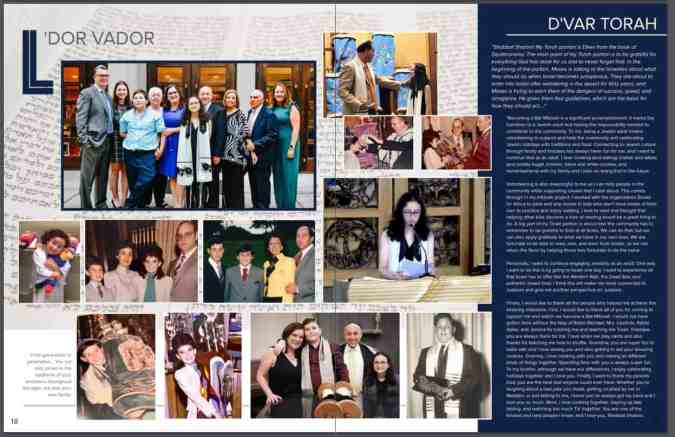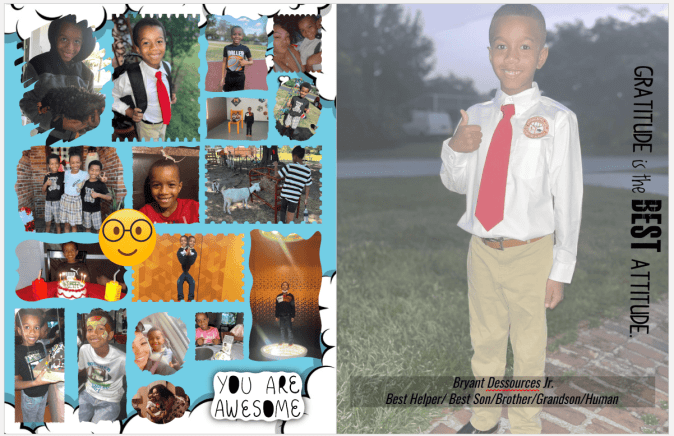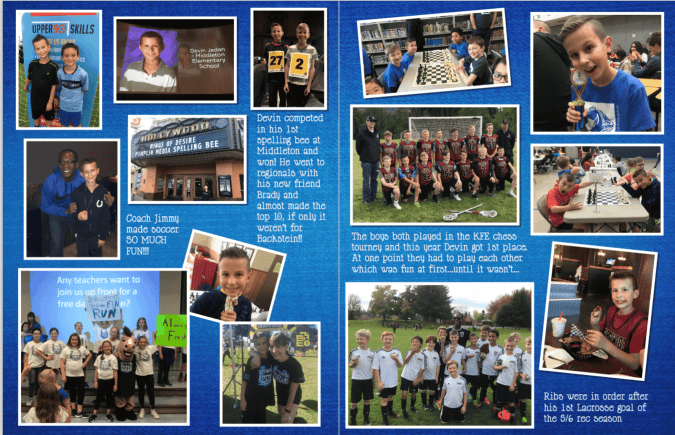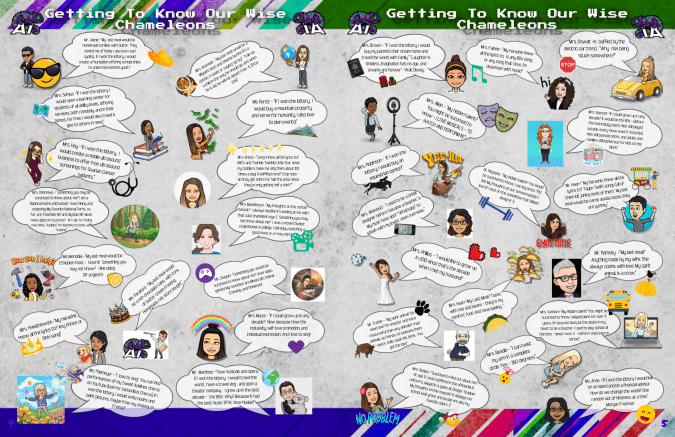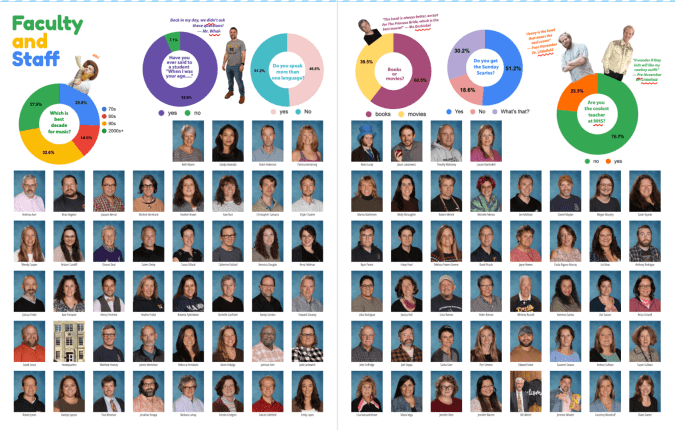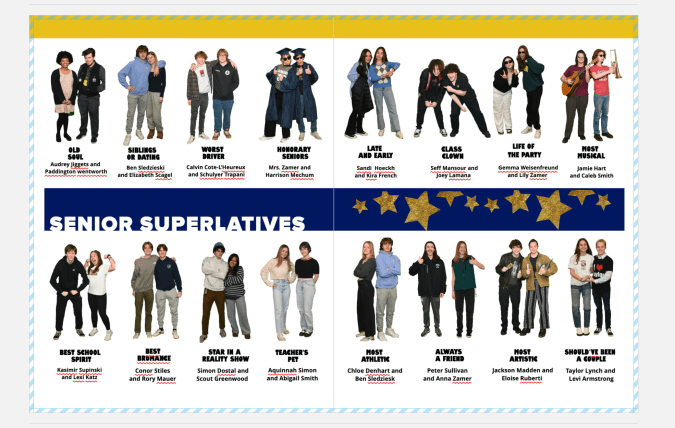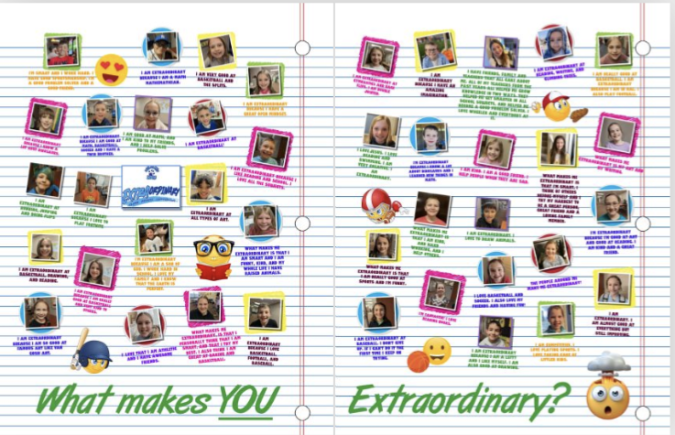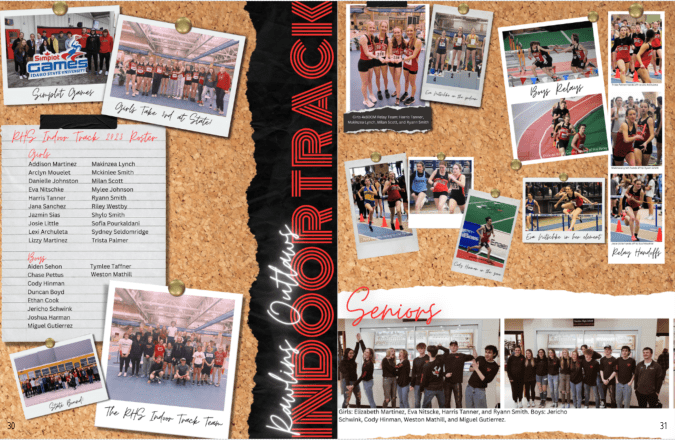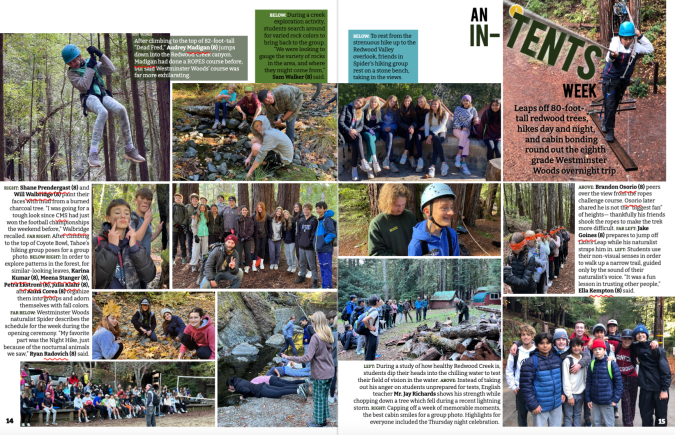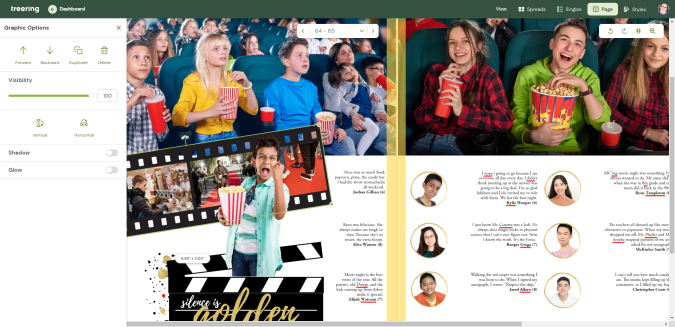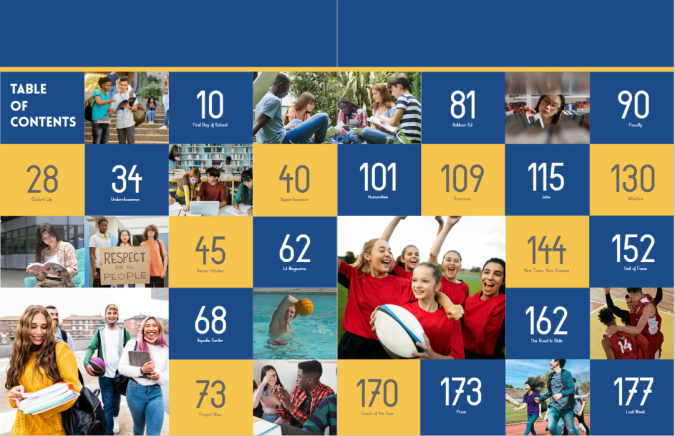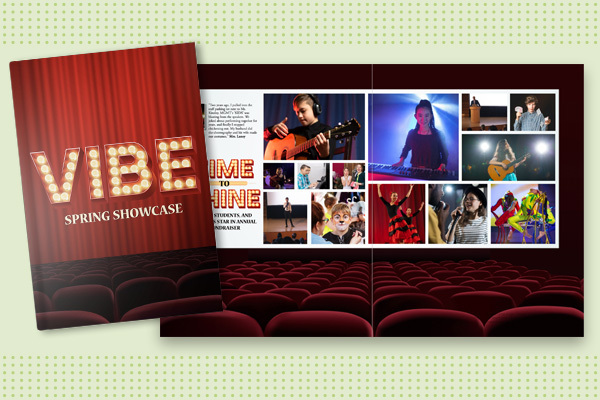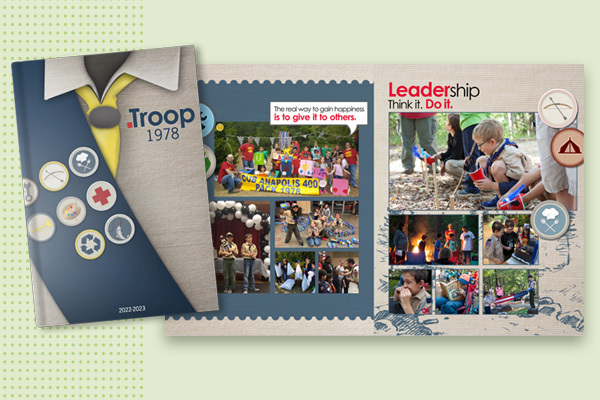Design
Looking for inspiration, design tricks, how to make a great cover, promoting your yearbook and engaging your community?
Most recent

7 yearbook mistakes to avoid
Avoid common yearbook mistakes with these tools and tiny changes to up your design and proofing game in the nth hour. Panicked, you shout, "Do I even have time to make changes?"
You'll make the time to avoid notoriety like this. 💚
1. “Unintended Cropping”
Eeek: you created a legendary layout, and then, poof. A classmate vanished. Unintended cropping is a nice way to describe the disappearance of a student caused during printing and binding. So often we focus on proofing and editing yearbook copy, that we neglect our showstopping images.
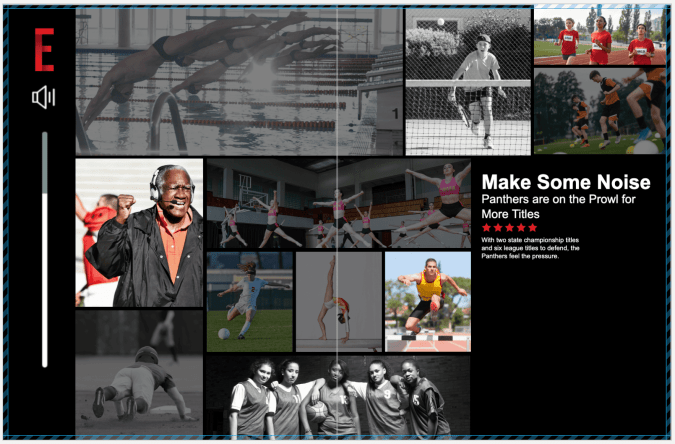
How to Proof Photography
Take precautions with photos on the edge of each page: the gutter between facing pages and the bleed areas can be problematic. Double-check both.
Gutter Space: This is where the yearbook pages meet at the binding. Be mindful of the gutter when placing photos across spreads. Avoid the mistake of placing important elements, such as faces or text, too close to the gutter to ensure they are not "cropped" in the binding process.
Trim and Bleed Areas: If photos extend to the edge of the page, ensure they extend beyond the trim line (where the printer cut your pages) into the bleed area. This prevents white borders from appearing along the edges of the printed page due to slight shifts during trimming. Keep faces on the inside of the trim lines.
2. Poor Photo Quality
Another photo mistake has to do with our favorite extension of ourselves: our phones. Cell phone photos print beautifully in the yearbook when you follow these caveats:
- Since original images work best, set up shared folders so parents, students, and teachers can share directly. This ensures that the highest quality version of the photo is available for printing.
- Avoid destructive edits and filters; if you’re not using Lightroom, chances are, you’re ruining the photograph’s quality.
- Beware of texting photos, as some apps automatically reduce the file size.
Saying it loud for the people in the back:
- A screenshot is not a hi-res image.
- Your DSLR on auto will never get that volleyball in focus.
I feel better.
Built-In Proofing Tools
Treering warns you when your image may not print well while designing.
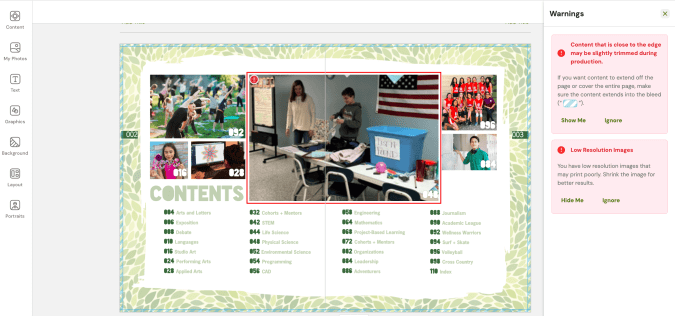
Your printed proof* is also the best guide. This allows you to identify any potential issues with image quality before officially going to print.
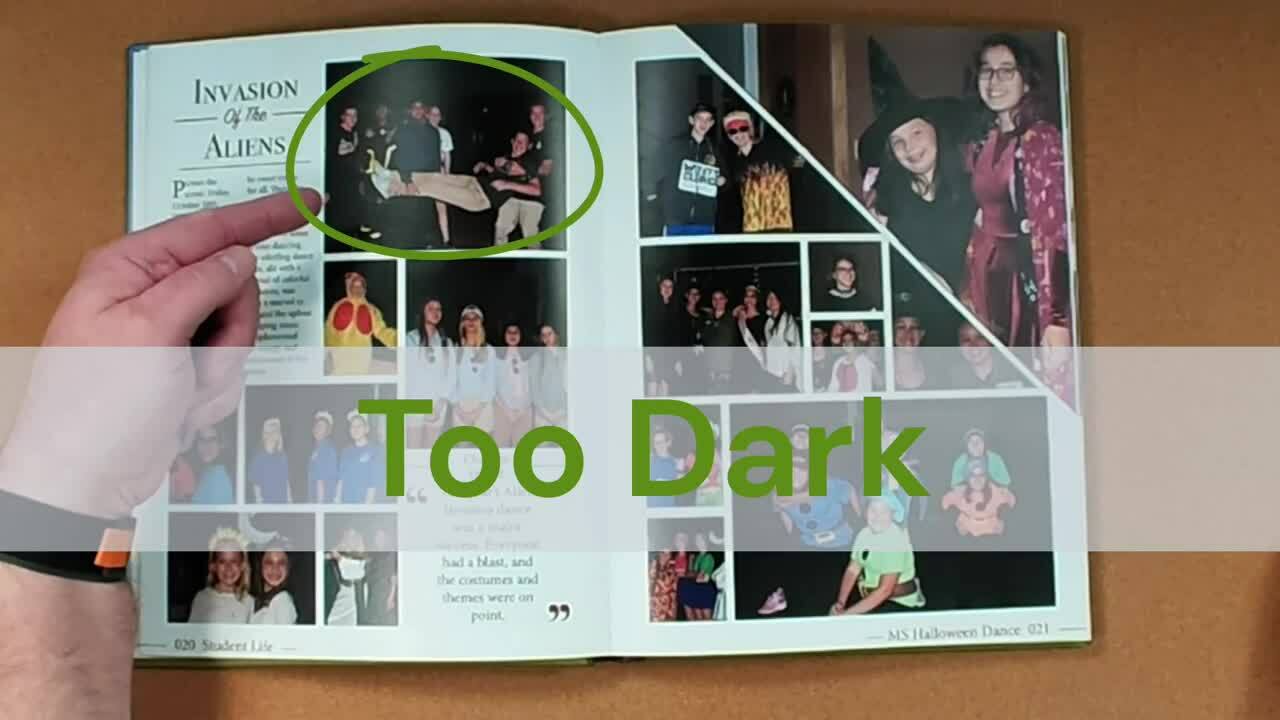
*A printed proof is just that: your yearbook as-is printed IRL so you can mark up mistakes, double-check contrast, and see your in-progress work. The best part: your Treering account includes one free.
3. The Same Kids Over and Over
And over. And over. Sometimes, it seems there are only two students on campus:
- The tri-sport athlete, who is also ASB president, the lead in the spring musical, a student ambassador, in eighty-five (OK, it just seems like it) AP classes, and works part-time as the PM custodian.
- The student whose name is on the roster.
Both are valuable members of the campus. The second is a little harder to find.
Creative Yearbook Coverage Ideas for Camera-Shy Students
Include more students (like #2 above) with modules dedicated to
- Student spotlights and mini-feature stories
- Academics coverage through classroom candids
- Artwork and gallery spreads
- Quote bars
- Pet photos
4. MIA Spring Sports and Events
We see it all the time in yearbook adviser groups: the woe of covering the final quarter of school with a traditional publisher. If your multi-year contract leaves you with no options, try
- A spring supplement
- Creating photo slideshows and linking them via QR codes
How Do I Include Spring Events in the Yearbook?
With yearbook deadlines in February, a supplement used to be the only way end-of-the-year activities made it in the book. Technology changed that. With digital printing and a three-week turnaround, spring sports, ASB elections, and award ceremonies can be in the book.
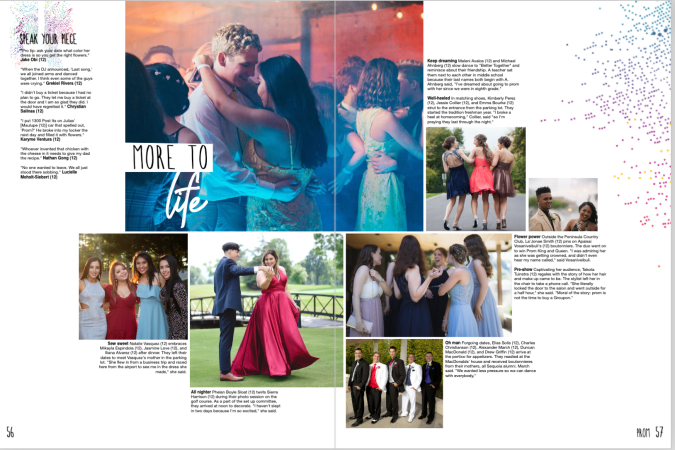
Need even more time? Treering’s ship-to-home option eliminates the summer shuffle and back-to-school distribution.
5. Inconsistent Formatting
Someone once told me if a bunch of yearbook advisers were in a room and our proofs fell on the ground, we should be able to rebuild our books just by the the design consistency. It’s a mistake to not have a cohesive look.
New to yearbooking? A templated solution may be the best. A Treering theme built with consistent formatting elements maintains uniformity across pages and sections.
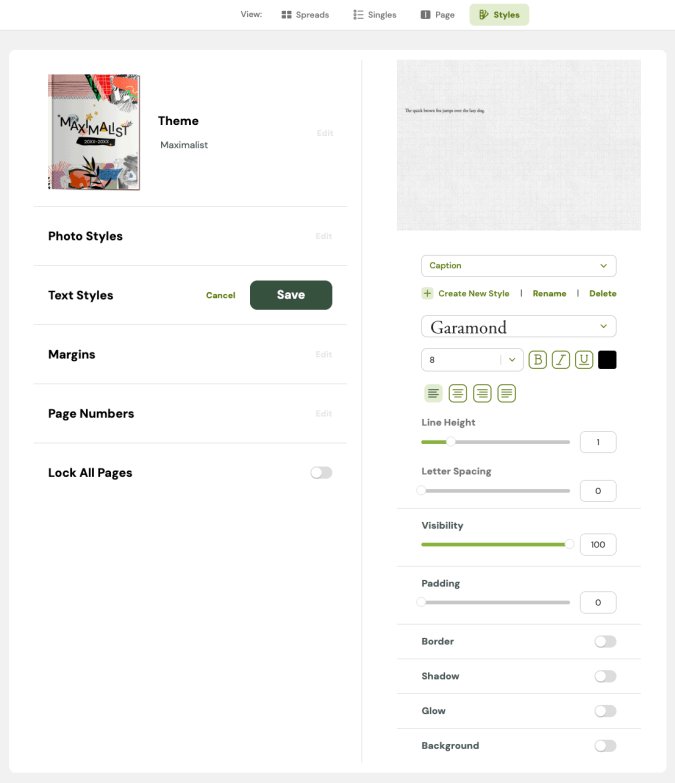
Use the styles panel to establish guidelines for text (size, alignment, formatting) and images (border, effects) to ensure consistency. While you can have all the styles in the world (please don’t), make sure they are intentional.
When in doubt, use Garamond for body copy (8-point for captions, 6-point for portrait names). If it’s good enough for Harry Potter, it’s good enough for your yearbook.
6. Ignoring the Principles of Design
Piggybacking on formatting, we’ve all heard the adage, “Learn the rules, then break them.” The rules exist for a reason. (Did you read that in my teacher voice?)
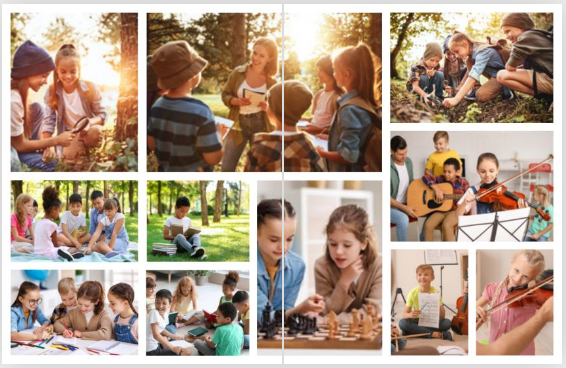
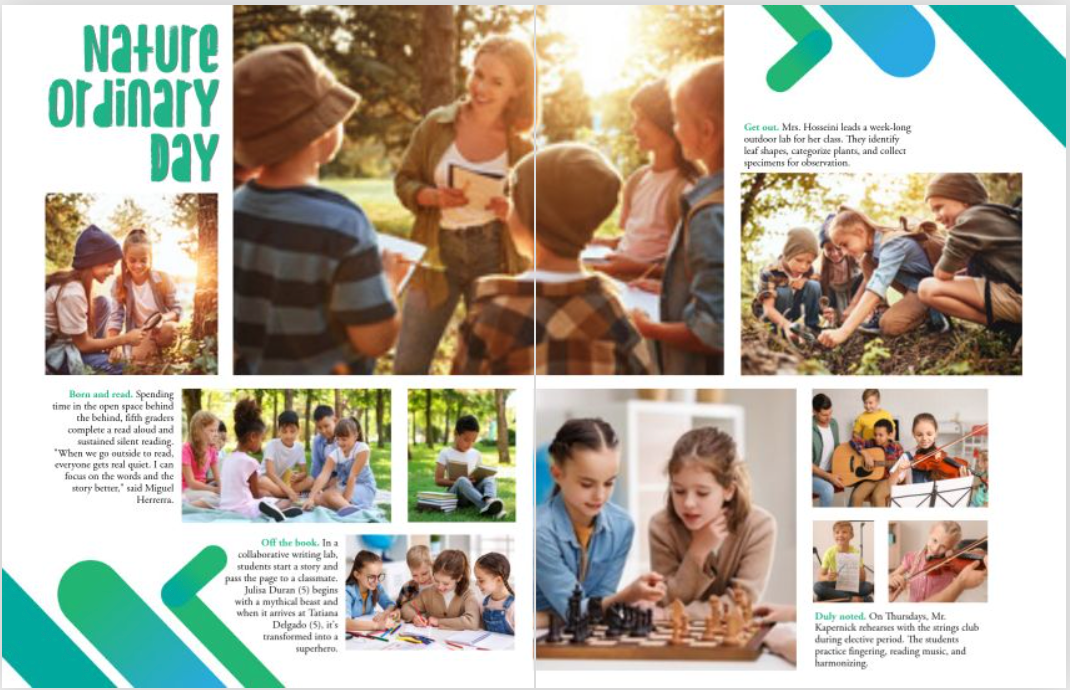
Design 101
Designing from scratch? Start from the center and move out.
- Place your dominant photo. Contrast in photo size helps guide the reader.
- Build out related content. Captions help identify the subject of the photo and supporting images give the full event story.
- Add secondary content. Use pull quotes, interview bars, modules, and graphs to diversify your storytelling.
- Add theme visual elements. Everything should go back to your theme. Everything.
7. Costly Yearbook Overruns
Sales quotas and surprise boxes of “extra books” add up. The same digital printing that allows for a three-week turnaround also gives you peace of mind when it comes to ordering. Say goodbye to guesstimating in November what you’ll distribute in May. Treering only prints pre-paid orders. This way, every year is a sell-out year. Additionally, there’s no waste and no leftover books.
Yearbook mistakes occur in design and coverage, affecting the quality and reception of the final product. The simple changes above, including proofing, understanding how design affects the (no pun intended) whole picture, and using back-end tools that help–not hinder our process–you can elevate the overall vibe of your yearbook program.

Yearbook in 60 days - part 3: yearbook design
Two blogs ago, we began our journey to start and finish a yearbook in 60 days. From establishing a ladder and crowdsourcing structure to flowing portraits and adding in fall events, the first month yielded a near-complete yearbook. These next fifteen days of our adventure include proofing, promoting, and packing in spring events. All the resources you need are linked below (for help center articles, you will need to log in to the editor help center).
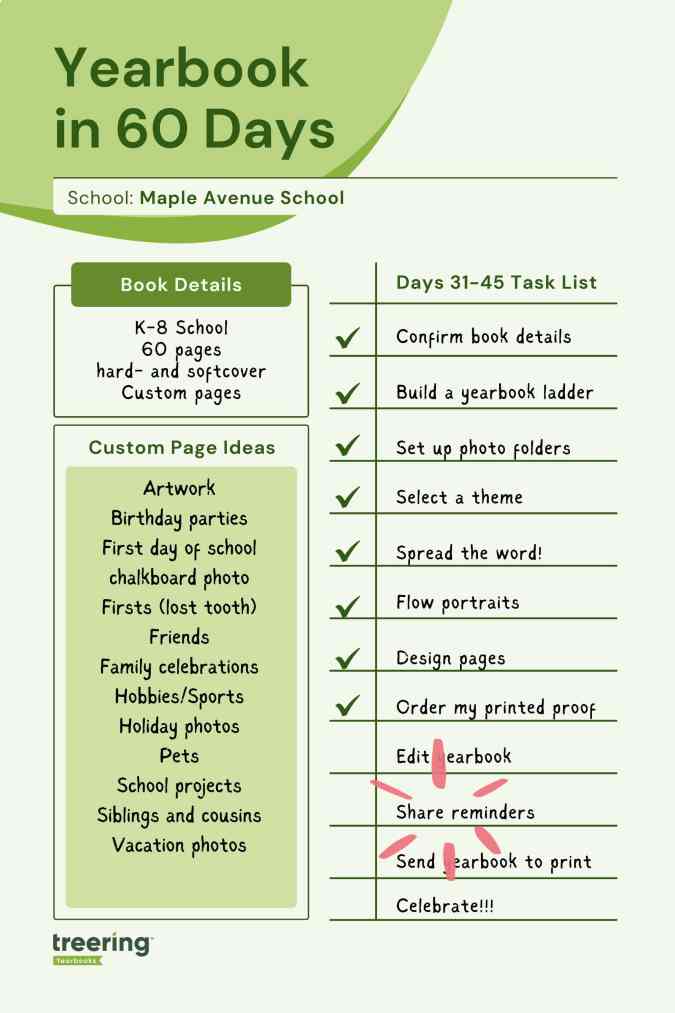
Yearbook (yes, it is a verb) along with us on Facebook, Instagram, and TikTok.
1. PDF Proofing
Just because we are speeding through the yearbook creation process doesn’t mean we will be careless. Proofing tools such as downloadable PDFs and a free, physical cover-to-cover proof of your yearbook are free through Treering.
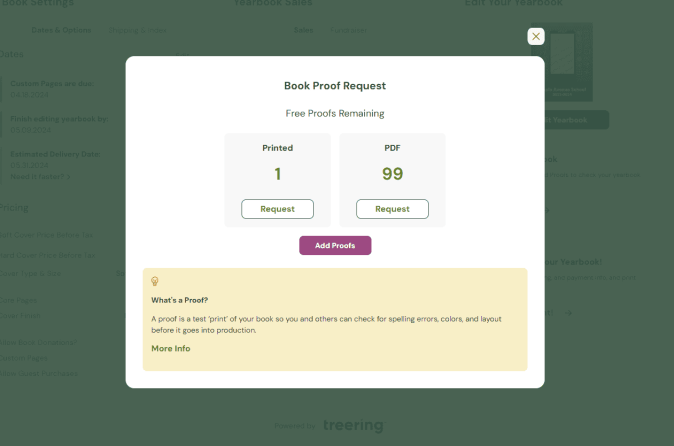
Let’s start with PDFs. English teachers everywhere will tell you errors that are missed on the screen often pop on paper. Read any copy (stories and captions) aloud to assess for tone and errors that digital proofing tools missed. These are low-resolution (the actual print file size might crash your computer), so you can download them quickly.
Use your PDF proofs to also
- Triple-check your portrait pages: correct spelling of names, the accurate placement of students and teachers in classes or grades
- Ensure faces aren’t lost on the edges (margins) or in the middle (gutter) of your spread
- Students are visible in the photos: sometimes, a photo box is the wrong size, and the faces are either huge or unrecognizably small. When possible, try to make all faces on a collage spread the same size.
- Show sneak peeks to your buyers - when parents see their child is in the book, they will buy the book!
Pro tip: use as many of your 99 PDF proofs as possible!
Yearbook Editing Resources
2. Design Pages (Spring/Second Semester Events)
Last time, you learned two ways to design. Because the second semester is unfolding as you build your yearbook, it may be easier to collect photos. This is the time to evaluate those first semester spreads: if they are not full by now, combine events and re-allocate space.
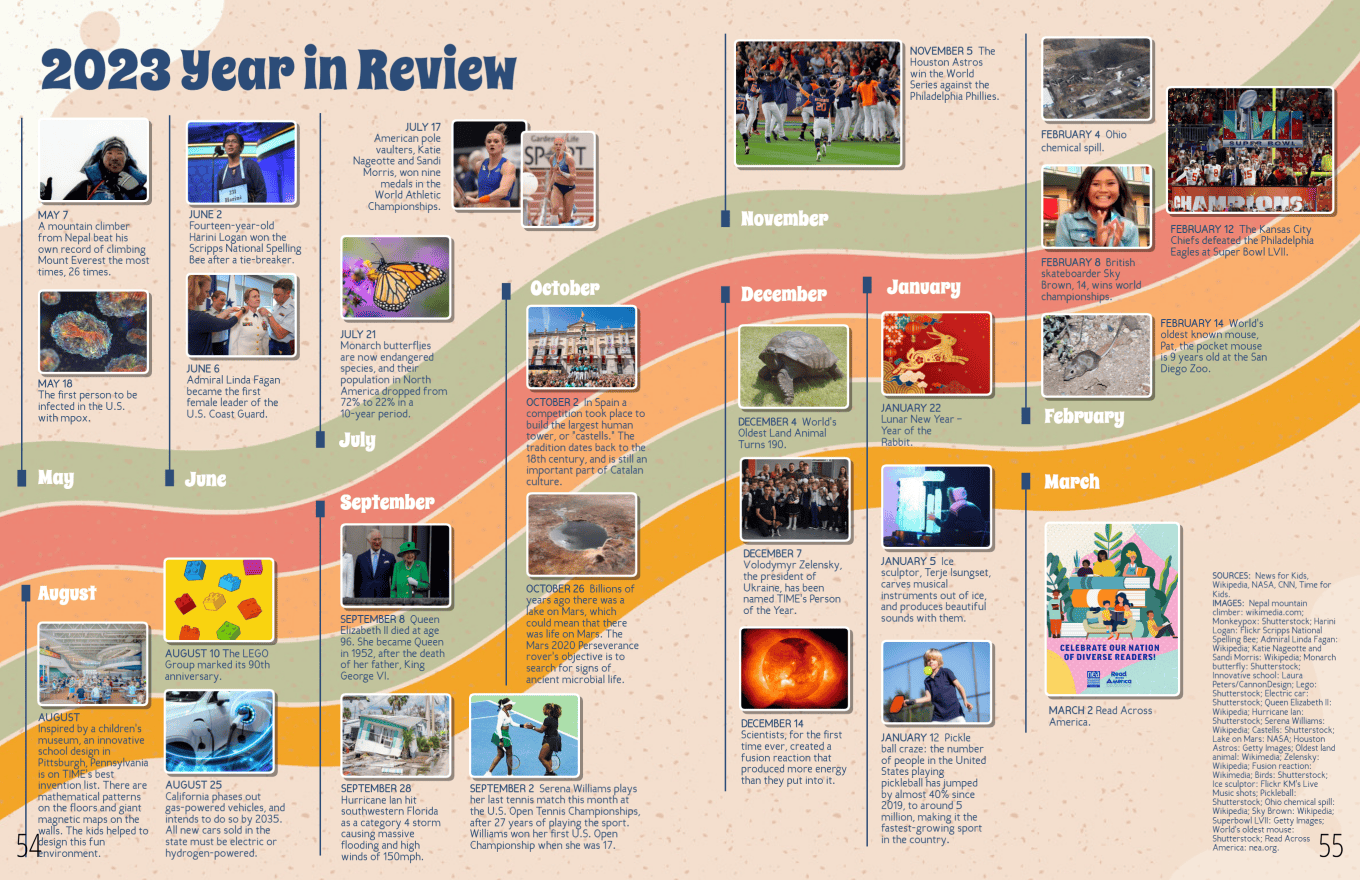
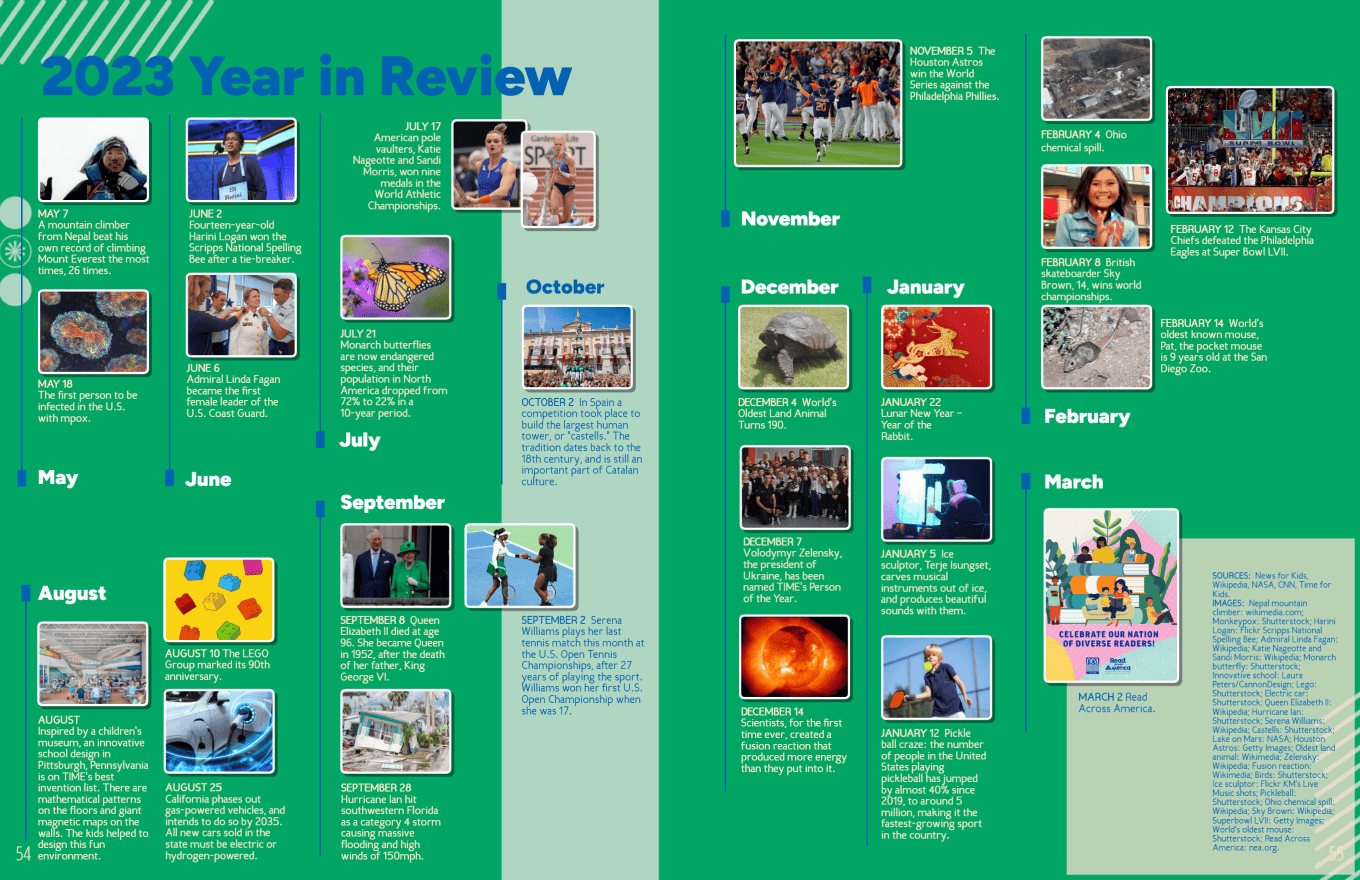
Coverage Resources
- Blog: Six Ideas to Fill Pages in Your Yearbook
- Article: Adding Pre-Designed Pages (You must login to the editor Help Center to view)
3. Purchase Reminders
In these remaining 30 days, up your promotion game by doing at least one thing a week to share about the yearbook:
- Reach out after each school event with the appropriate photo share link and email
- Call or email parents of students who are in the book three times and have not purchased
- Have a contest: the grade or homeroom with the largest percentage of purchases earns extended recess
- Remind purchasers to customize their yearbooks (more on this next time)
- Ask campus influencers (ASB, PTA/PTO accounts, athletics) to hype the yearbook
- Have flyers at a school-wide event, such as the band showcase
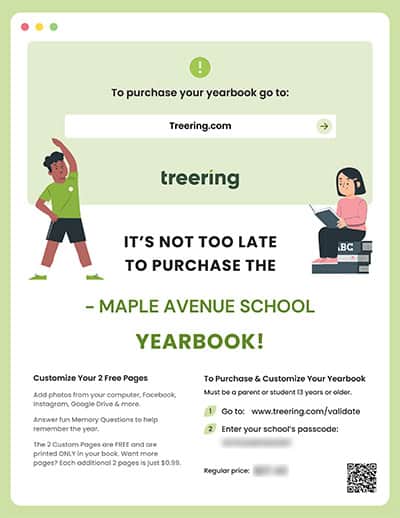
Yearbook Sales Resources
- Google Slides: Customizable Flyers
- Article: Tools for Promoting Your Yearbook
- Blog: 5 Social Media Posts to Sell Yearbooks
4. Printed Proof
Treering’s Marketing Manager Megan P. likes to say, “Works in progress welcome!” Because you need your printed proof in hand before your final deadline, order it now. It can take up to 18 business days for this yearbook freebie to arrive.
With portraits and fall events in the book, there is plenty to evaluate. Use your remaining PDFs for copy and photo edits.
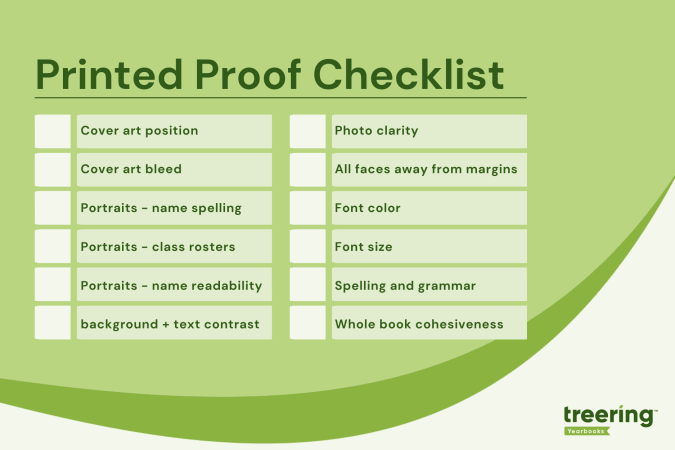
Pro tip: When my printed proof arrives, I take a Sharpie and mark it up. Then, I use it as a tool to clean up each spread one by one.
Proofing Resources
Yearbook with a Friend
Involve a second or third set of eyes during the proofing process. Potential yearbook proofing heroes include:
- Front office staff (they know all the things)
- Student TAs
- The secretary of the parent group
- Coaches and club leaders
- A friend who owes you a solid
Next time, we’ll send the yearbook to print and prepare for distribution.

How to create interactive yearbook pages
Adding an interactive element to your yearbook pages can increase engagement and personalization in a culture measured by double taps and shares. Interactive yearbooks can have modules or spreads where students can record their ideas or engage with content. (And if you know anything about Treering, we’re all about making yearbooks as unique as your students.) Below are four ideas, from drag-and-drop solutions to those requiring a bit more delegation (wink) for your yearbook.
Interactive = Personal
The most hands-off way to help others interact with your yearbook is Treering’s custom pages. These two free pages in every yearbook are prime real estate for artwork, celebrations, firsts (lost tooth, car, homerun, etc.), and what matters most to each family. Knowing they are creating a keepsake, many parents opt to add more pages.
These custom page examples from the Treering team include non-school sports, pets, milestones, and family trips.
All About Me Pre-Designed Pages
While seeing all that our school community achieved in a year gives us the feels, adding opportunities for students to share their take captures a deeper moment in time. It shows students how they contribute to the whole with their unique take on the school year. Adding an All About Future Me component allows students to dream. (Moms, it also gives us something to read aloud at their graduation, “Yes, Erikson, you really did aspire to be an underwater ninja.”)
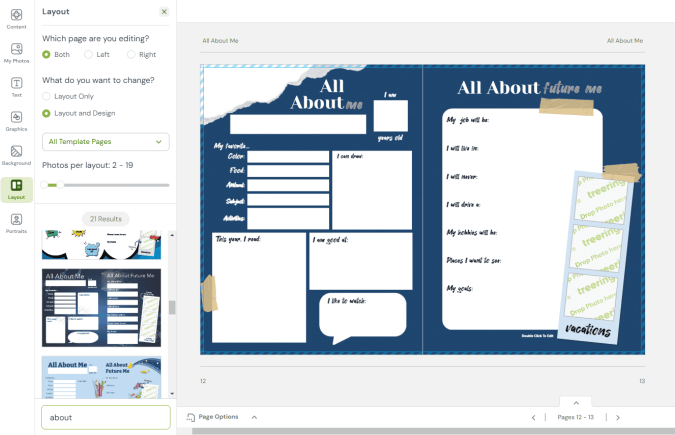
Pro tip: many Treering themes have these templates ready for you to drag onto a page.
Fill-in-the Blank Stories
Part 80s nostalgia, part English teacher ploy to get us to know our parts of speech, fill-in-the-blank stories can range from nonsensical to [fill in the blank]. 😉
We created one you can copy and paste for your yearbook.
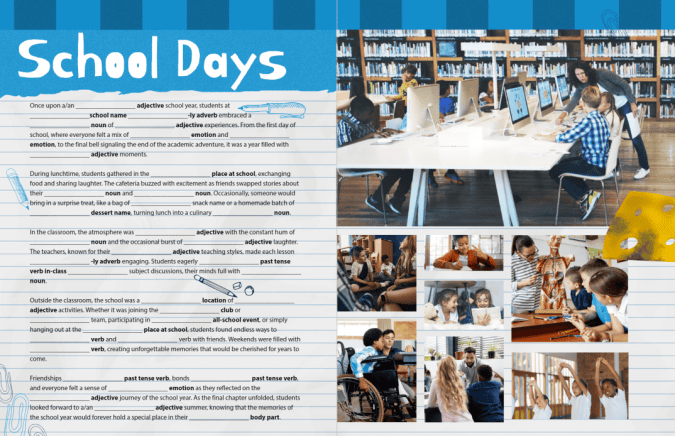
Puzzles
Including puzzles in a yearbook enhances personalization because they can play with words, images, and situations unique to your campus, fostering a sense of ownership. Simultaneously, these activities bring additional engagement into the yearbook, making the publication more dynamic. You can choose to add content with words and pictures.
Word Puzzles
Word searches, crossword puzzles, and the like add an entertaining interactive break from traditional pages. Additionally, for younger students, they can be a means to involve family members who may enjoy solving the puzzles with their child, creating another shared yearbook experience.
Include things in your puzzles such as school subjects and the
- Mascot
- School address (street and city)
- Special events or all-school activities
- Principal’s last name
- Names of clubs, teams, or electives
An online puzzle maker can help you customize an interactive puzzle.
People Matching
More fun than a history quiz, a yearbook matching module is a way to use your interactive content to increase coverage. Answers can share a page with the colophon.
Match
- Students to cars
- Baby photo to the students or teacher
- Teachers to their first job
- The cleat to the sport
- The fundraising total to the class
The easiest ask: pets.
Side note: maybe I should have titled this, “Gamify your yearbook.”
I Spy
There are two takes on this:
1. Search for objects such as eight basketballs, 14 pencils, and five nets. These items already exist within a section or the yearbook as a whole; you're just asking the student body to take a closer look.
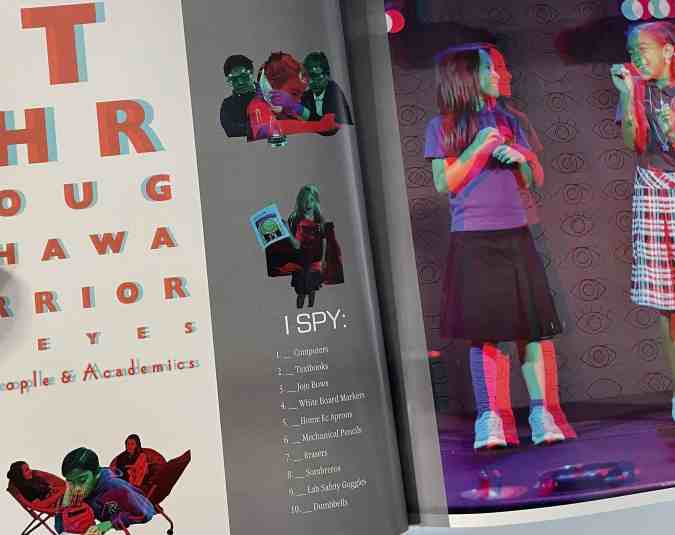
2. Find a person. This is the most labor-intensive: hide a COB of your mascot throughout the yearbook. (Yearbook Hero Katie Parish had a great take on this.)

Adding one or all four of these interactive yearbook page ideas gives students a place to reflect, share their “voice,” and foster a sense of community ownership of your collective narrative.

Gold yearbook themes
Adding a spot of gold is a growing yearbook trend. And we love it! While gold is a go-to accent for a 50th-anniversary book, use it to capture the spirit of 2024. See how easy it is to build a gold-themed yearbook with these design ideas and headlines.
Free Whole-Book Looks and Yearbook Templates
You don’t have to begin with a blank book. Opting for a theme package is a time-saving alternative if crafting one from scratch seems overwhelming. These four golden packages by Treering Yearbooks below streamline the design process and are fully editable.

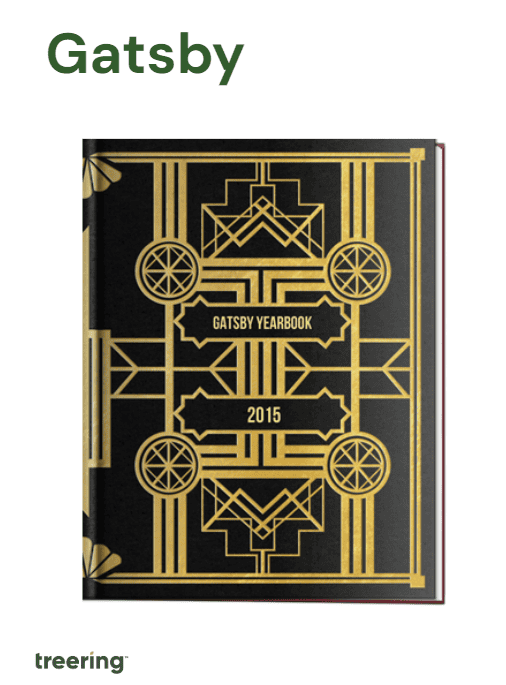
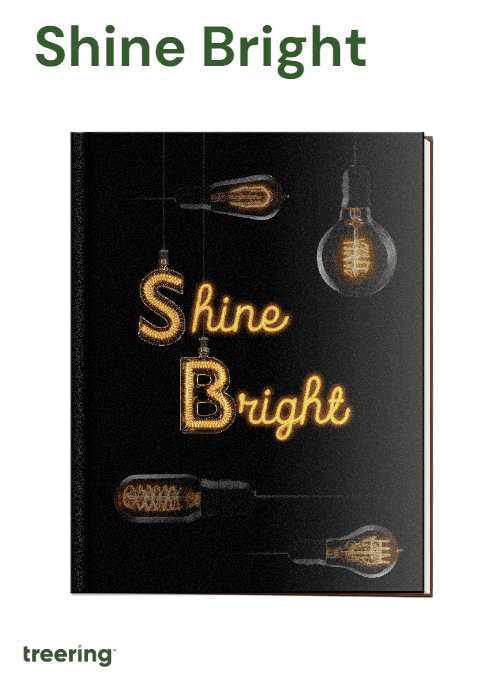
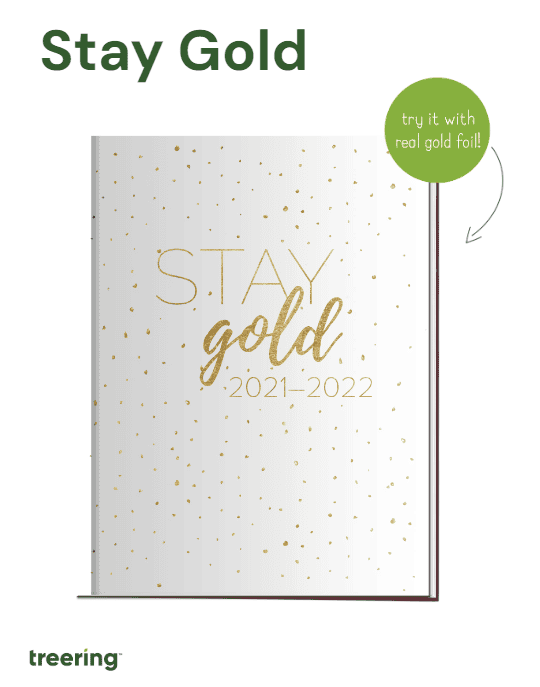
Gold Foil Yearbooks
Adding optional gold foil to the cover draws attention to specific elements like the school name or key theme graphics.
These two resources will help you begin:
Advice as Good as Gold
“A [Treering] theme does a lot of the graphic design work for you: it’s like giving your students fill-in-the-blank notes as opposed to having them copy them by hand,” said Yearbook Hero Lauren Casteen.
She and her team select one or two of Treering’s graphics packages and adapt them to tell the story of the year. They design layouts from scratch using the backgrounds, overlays, and other included visuals to build their style guide. Read more on Casteen’s approach to teaching design alongside using Treering here.
More Than Just a Look
A visual theme becomes stronger when headlines connect content to create a story. Your gilded yearbook theme is more than a color scheme; it’s a clever play on the year (‘24) or a way to highlight a milestone (e.g., 50th anniversary). Here are some headlines to align your verbal and visual theme.
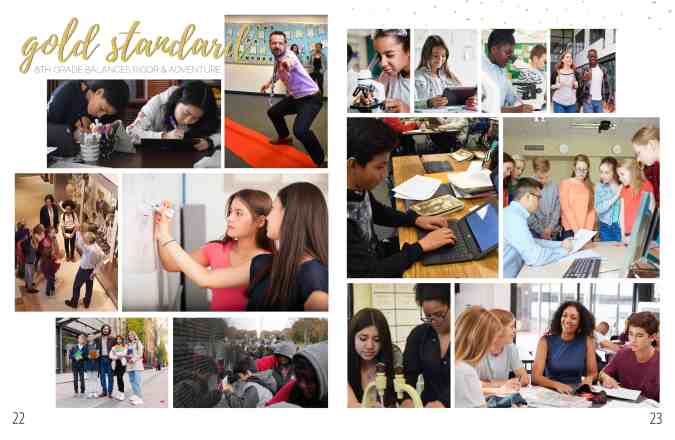
Headline Ideas
A gold yearbook theme needs some golden headlines. We love browsing an idiom dictionary to create a list of headlines and spinoffs. Pro tip: an idiom dictionary is a great place to start with any theme.
- Worth its Weight in Gold
- Gold Mine of Information
- Heart of Gold
- Gold Standard
- Silence is Golden
- Golden Girls
- Gold Star(s)
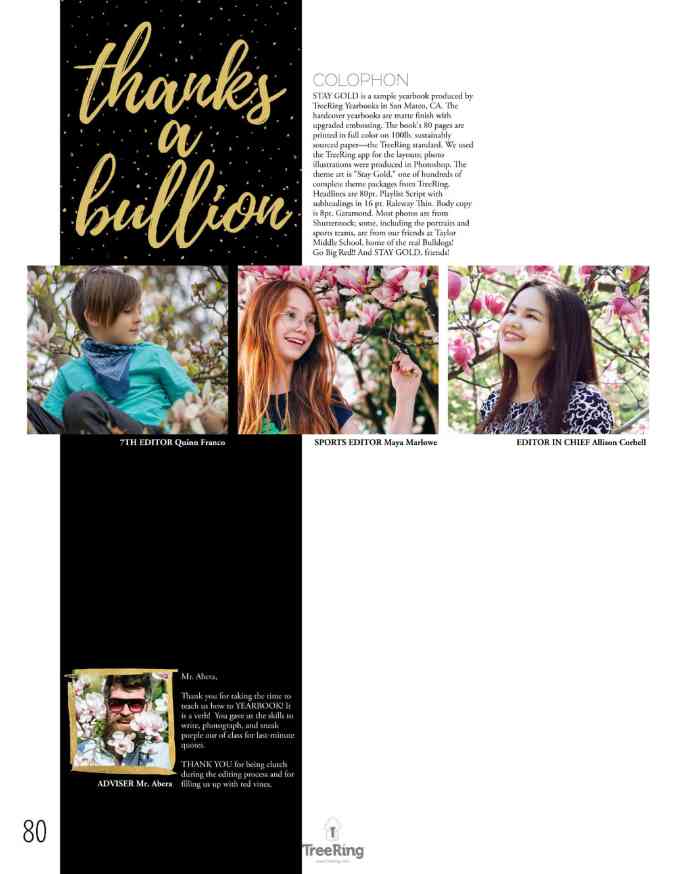
Punny Gold Headlines
Puns, while a particular favorite of this adviser, are best used when peppered in. Using too many becomes like white noise and runs the risk of being unfunny. (The horror!) Remember, if one person doesn’t get it, chances are, many of your readers won’t–case in point: the Ponyboy Curtis reference above.
- Au-some
- Glitter of Speech
- Gold Feet - soccer or step team
- Golden Age of the [mascot]
- Goal Diggers - volleyball
- If I Gold You That
- Thanks a Bullion
Headlines Using Synonyms
As with puns, too many Gold This and Gold That headlines diminish the luster. Brainstorm a list of synonyms to use, and then search your idiom dictionary for new nuggets.
- All that Glitters
- Rain or Shine
- Rise and Shine
- Sea to Shining Sea
- Shine On
- Shining Example
- Take a Shine to
Writing Your Own Headlines
If a curated list is too much of an easy button, and you want to teach the process, here are five steps to craft a headline.
- Review the spread and sum up the coverage in a single sentence.
- List five keywords from the coverage.
- Look up idioms and/or puns incorporating those keywords and their synomyns. Compile a list of five to ten before moving on.
- Evaluate which headline idea achieves the goal of accuracy, clarity, and interest.
- Revise and rewrite until the answer is “yes” for all three.
To dig more into a goldmine of theme development, check out

What is modular yearbook design?
Modular design for yearbooks is an approach to layout and design that emphasizes flexibility (just like your favorite yearbook company) and ease of content organization. Small, self-contained modules include photos, copy, and other theme content. With multiple reader entry points, a modular layout contains three or more, each telling a different story.
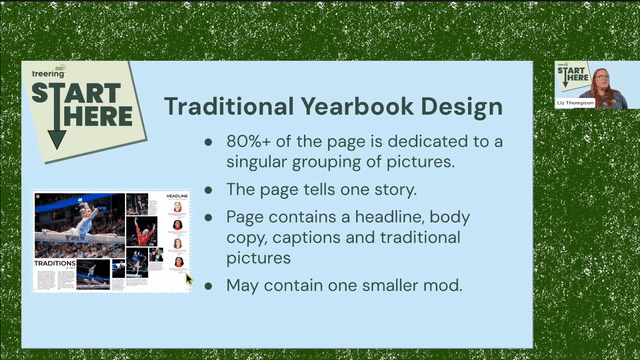
Learn the difference between traditional and modular design.
Four Modular Layout Ideas
Because modular design has many interpretations and applications, we pulled together four different looks.
Idea 1: Let Your Story Be Your Guide
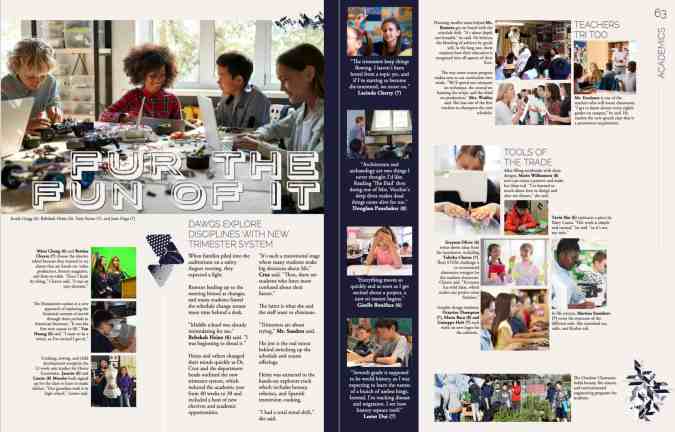
This spread covers the middle school schedule, media program, study habits, and electives in six modules. There is a large amount of copy beyond the feature story and a quote "sidebar" running down the middle of the spread.
Idea 2: Give the Whole Picture
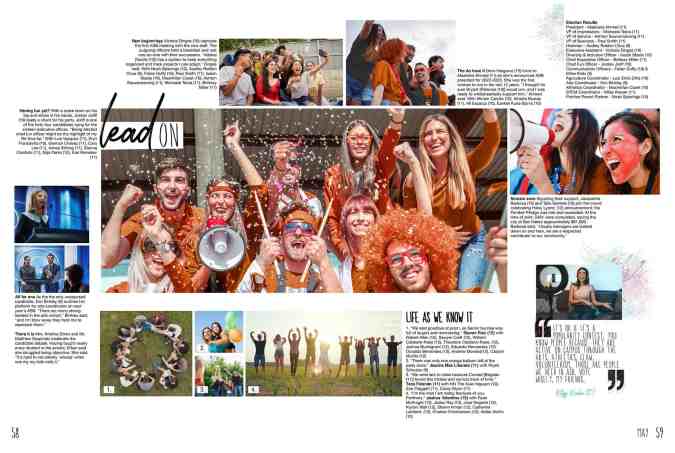
This varied collection of mods includes a quote package, personality profile, election results, and event coverage. In a chronological yearbook, such as this, modular layouts help organize myriad stories on a single spread.
Idea 3: Start Small
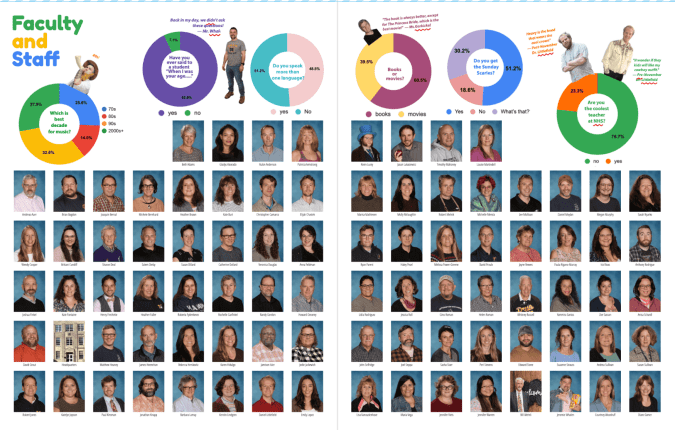
Not only did the six polls reveal more about the faculty, but the yearbook editors added quotes and cutouts to teach us more. Adding a mod to the people or reference section is one way to add voices to an otherwise flat section.
Idea 4: Drag and Drop
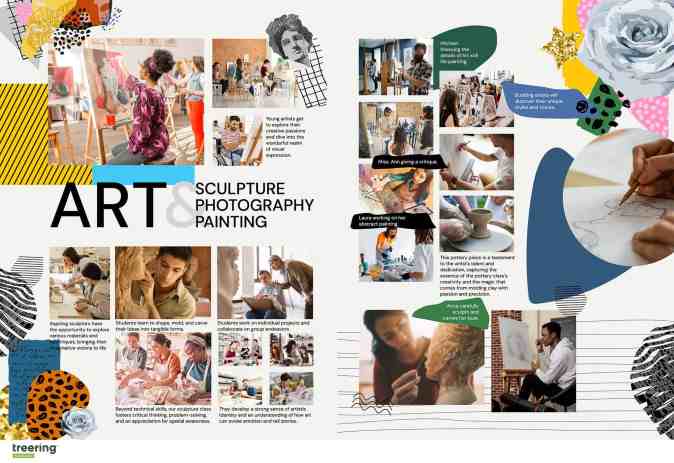
Low on copy, high on images, this sample spread with four modules provides ample space to detail aspects of art creation. As-is, this layout is available with the others in the Maximalist theme under layout and design for Treering Yearbooks editors. Other modular themes include Tropical Chronicles and Tied Together.
Layout Tools and Tips
Treering Yearbooks' built-in tools to help you create your own layouts and modify ours in a few clicks.
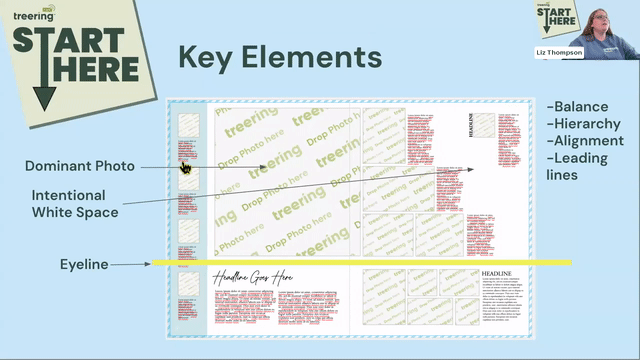
Treering design school in under 18 minutes.
Pros and Cons of Mods
While modular design increases coverage opportunities, it takes more planning from your editorial team.
Pro: Coverage
Devoting a spread to one topic limits the coverage to one group. Opening up a sidebar or two increases your possibilities to tell more of the year.
Pro: Collaboration
On larger teams, modular design facilitates collaboration among a team of yearbook contributors. Section editors can distribute interview and photography assignments by topic.
A quick note for advisers: assigning module topics is also a way to combat the “I have nothing to do” line that tends to get tossed around the newsroom.
Pro: Consistency
Recurring modules maintain a consistent look and feel throughout the yearbook, which strengthens the theme and overall design.
Con: Planning
Frankly, some content may not neatly fit into modular structures. It’s fetch. And if not managed carefully, modular design may lead to overusing the same design elements. There’s a fine line between consistency and monotony.
Yearbook Module Ideas
The most popular yearbook mods tend to be sidebars with a question-and-answer format. If you want to add something new to your yearbook layouts this year, this is one way to increase coverage and develop open-ended questions.
Consider building in these additional modules:
- This or that: fashion, fandoms
- Matching: teachers with their first jobs, the shoe to the sport
- How-tos/step-by-step: prep for an inside and outside pirouette, outline a DBQ essay
- Flat lays: teachers’ desks, backpacks
- Essential gear: art kit, robotics team
- Timelines: getting ready for a school dance, fundraiser from start to finish
- Lists: five ways to welcome new students, 10 reasons people auditioned for the spring musical
This blog is adapted from Liz Thompson’s Design 201 session from TRL 23: Start Here. Thompson, a former high school yearbook adviser, serves as a customer success manager with Treering Yearbooks.
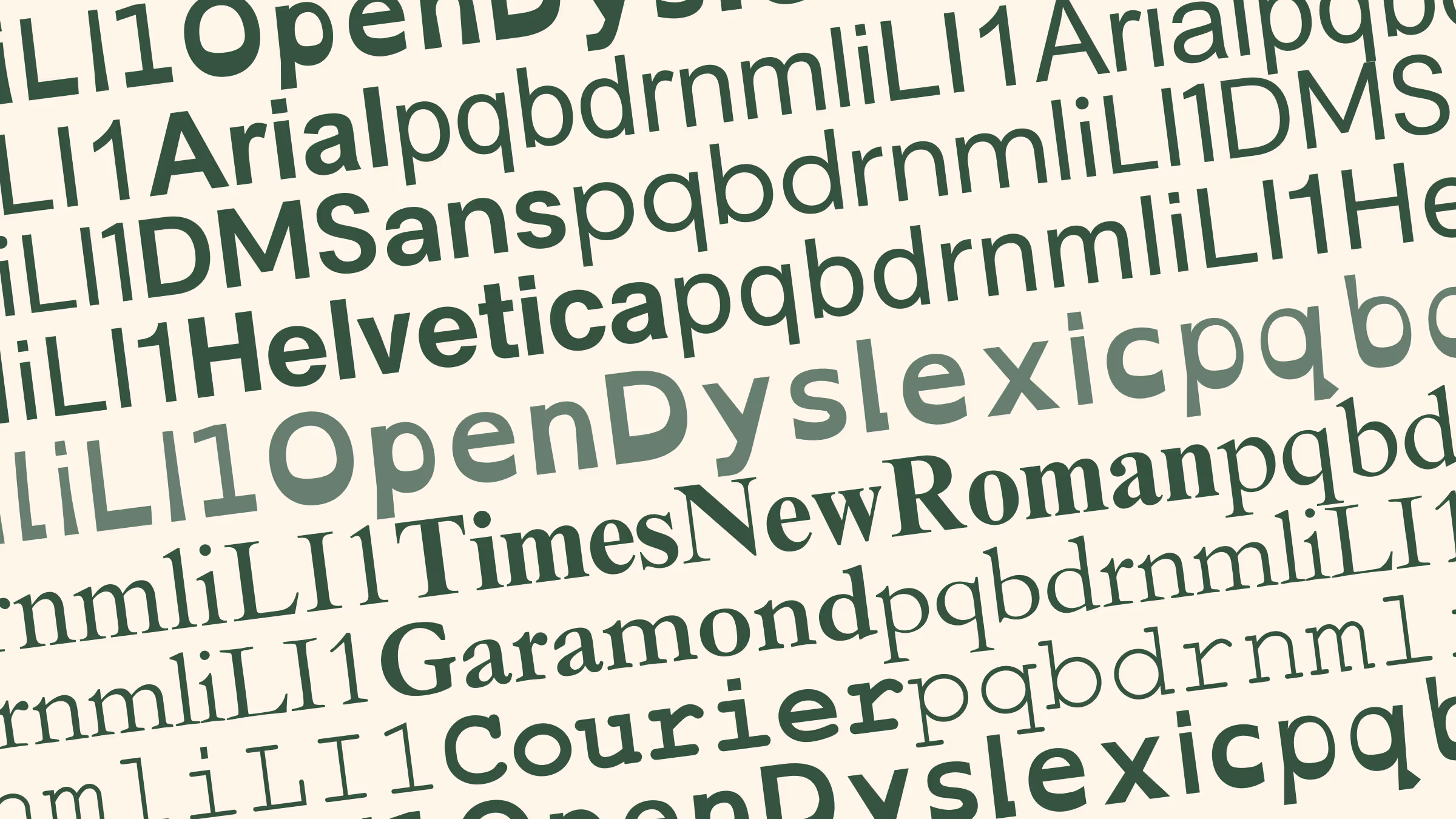
Making yearbooks more accessible with opendyslexic
Fonts can be the Marsha Brady of the yearbook world. Overshadowed by epic theme packages and color palettes, the power of typography cannot stay silent. (In fact, the correct font can be louder than your graphics.) With 44 new fonts in the Treering catalog, you can share your story with boldness or a touch of whimsy. It can be focused or zany, handwritten or high-tech.
“Typography, like other design elements, evolves over time. Keeping up with current trends ensures that your designs feel fresh, relevant, and aligned with contemporary aesthetics,” Treering’s Director of Design, Allison V. said. “Typography also strongly impacts how a message is conveyed and perceived. More importantly, we listen to our users and try to accommodate their needs and wants. We often receive requests for fonts and appreciate the input from you.”
One such request came in the form of a text.
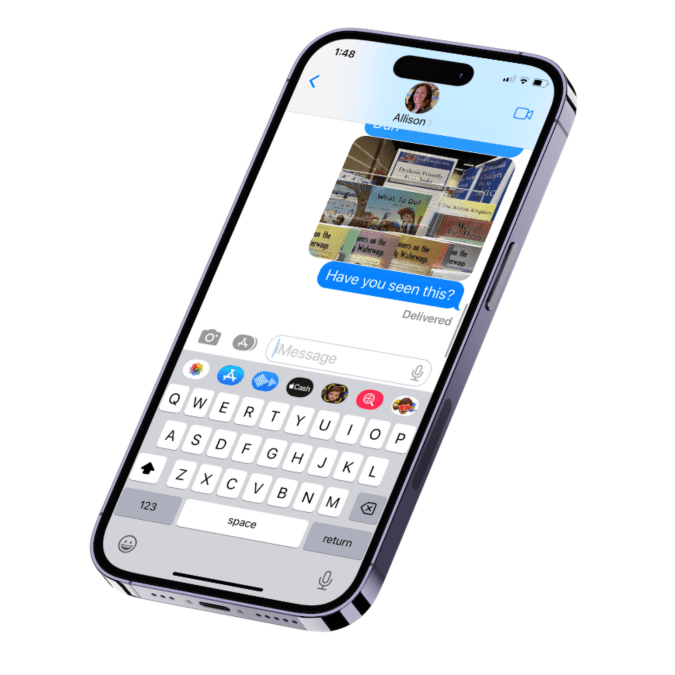
Meet OpenDyslexic
Since origin stories are a big deal in the superhero world, here is OpenDyslexic’s: app and game designer Abelardo “Abbie” Gonzalez developed the font in 2011 to help people with dyslexia improve their reading experience.
OpenDyslexic’s design addresses common challenges faced by many readers with dyslexia:
- Letter Weight: OpenDyslexic uses a slightly heavier letter weight, which helps the letters stand out more clearly on the page and reduces letter crowding. When designing for readers with dyslexia, avoid using italics or underlines because they cause letter crowding.
- Bottom Heavy: The base of the letters is slightly thicker, which provides better anchoring for letters. This can reduce the chances of them being flipped or reversed.
- Distinct Letter Shapes: The font uses distinct letter shapes to minimize letter confusion, such as avoiding mirror-image similarities between letters like "b" and "d."

Because it’s an open-source font, it is freely available. You can even make it your web browser’s font.
How Would You Use OpenDyslexic in Yearbook Design?
The short answer: headlines and captions.
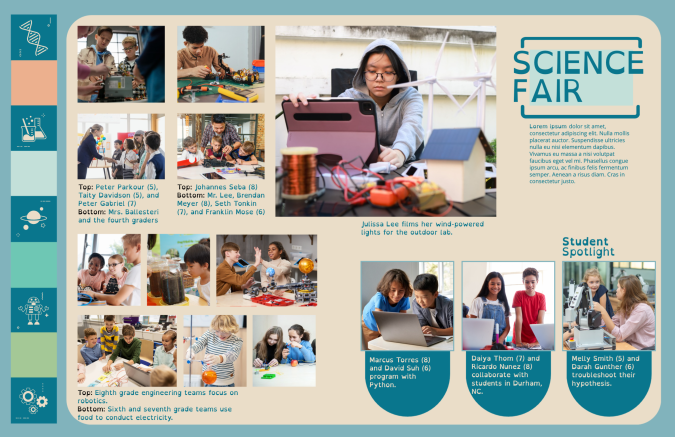
The British Dyslexia Association and the UX Movement established Dyslexia-Friendly Style Guides. Summed up, the following tips can increase the readability of your spreads.
- Modular design: use negative space to break up content into meaningful chunks
- Keep backgrounds to a single color, ideally cream or pastel peach, orange, yellow, and blue
- For text, ensure there is contrast between the background and words on your yearbook spread
- Left align text
- Use font size 12-14 pt.
As with anything, it is essential to note that while dyslexia-friendly fonts and design can be beneficial for some individuals, there is no one-size-fits-all solution for all learners. If possible, seek stakeholders' feedback during the design process to identify potential improvements.

Winners of the 2023 custom pages contest
As a new tradition initiated in the 2021-2022 school year, Treering's custom pages contest gave parents an opportunity to share the designs they create for their children's yearbooks. After narrowing nearly 500 submissions down to just 10, we took the vote to Treering's official Facebook and Instagram pages. The finalists earned thumbs up and hearts, respectively, while providing custom page ideas and inspiration to other parents. All ten finalists earned $50 from Amazon. The grand prize winner earned an additional $500 Amazon gift card.
On behalf of the judges and marketing department, we are thankful for each submission.
Grand Prize Winner: Lisa Ward From Keene, TX
It all began when her children asked for their extended family, who live across the US, to be in their yearbook. "We had a lot of fun reaching out to family to put together these pages," Ward said. "From California to North Carolina, Michigan to Texas, we like the reminder that family is forever!"
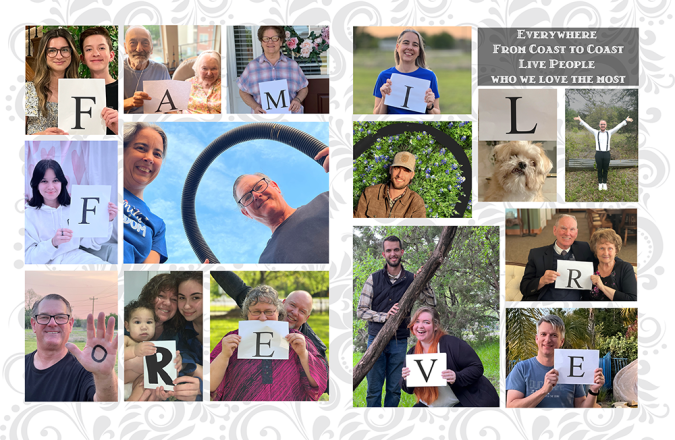
Why We Loved It
The core value of Treering's custom pages is for each family to make their child's book their own. Ward did that by involving her family. The coordination itself is award-worthy, not to mention the clever use of objects to center their "family forever" message with a heart.
Second Place Winner: Mary Frazee From Galt, CA
Frazee created a "Road Map" for her daughter's sixth-grade yearbook. "The pages feature all the fun things she learned and enjoyed along the way," she said. "I wanted to capture how much she has grown, and feature her first day of school photos for each year."
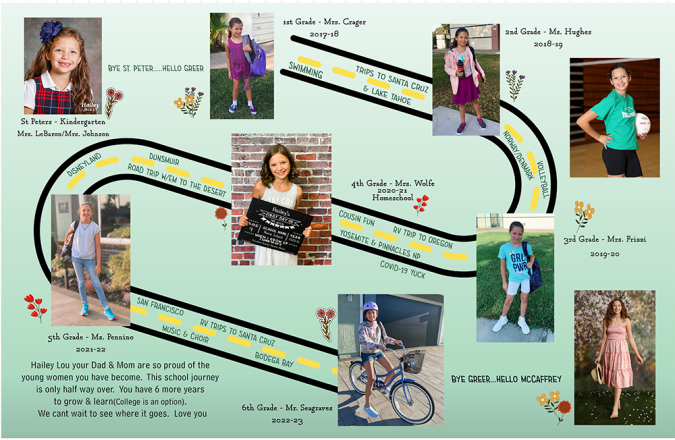
Why We Loved It
This is how you culminate an elementary school journey! The path from first through sixth grade showed all of Hailey's trips, achievements, and activities, as well as her teachers' names (the teachers on the judging panel felt seen). Using flowers to denote growth along the way, Frazee's design gives us a glimmer of the support and love in her home.
Third Place Winner: Sokunthea Mau From San Jose, CA
Mau wrote this to accompany her submission:
The media portrays high school as the peak of an American teenager's life. Can you blame them? The extravagant dresses at prom, the freedom teenagers have, the cap toss at graduation… As I went into my junior year of high school, I walked in with the mindset of every other try-hard Bay Area student: don’t mess it up. Junior year is coveted as being the most stressful time for a high schooler, due to the weight college admission officers put on this year. I overloaded myself with extracurriculars and difficult classes disregarding if I could manage everything all at once; in turn, my mental health plummeted and I faced burnout numerous times.
In spite of my struggles, I found myself crawling back to my comfort movies. The iconic opening scene in the Lizzie Mcguire Movie as she dances in her room replays in my head. What was it in these movies that made high school so appealing? The memories.
As I made this spread, I tried to envision myself as a stereotypical teenager gluing cutouts of my best friends on my page and listening to radio pop songs. I wanted to show what I wanted to reflect on when I remind myself of junior year, not the tests I failed or the classes I cried about, but the memories that kept me going. Like every movie coming to its resolution, my junior year has begun to tie up its loose ends, preparing for the credits and the uplifting background music.
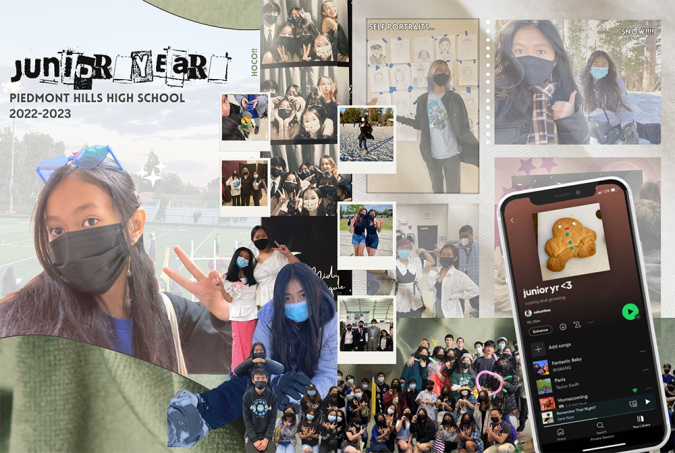
Why We Loved It
As if Mau's verbal story wasn't enough, the application of her strategy won us. (Full disclosure: many of the judges lived through the days when you physically cut out and glued photos for yearbook pages.) Using her custom pages as a catalyst to bring joy back into her junior year, she also brought that positivity into ours.
"I love the many layers this spread has to offer," one judge said, "The texture of the fabric across the page adds even more depth into the junior year through the eyes of Mau. These little touches, I think, round this spread out and complete it."
Within her two pages, she told her story her way.
Meredith Lanning From Katy, TX
Lanning used her son Zach's pages to add additional band coverage to his yearbook "from marching season, competition show, dances, and best of all the Spring trip to Hawaii," she said. (This is just one of the eight she created.)
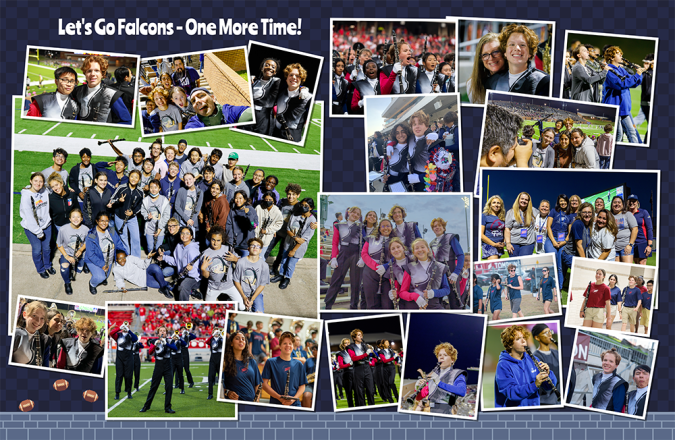
Why We Loved It
Lanning's behind-the-scenes look at her son's marching band shows the camaraderie and effort that goes into producing halftime shows. She anchored the spread with a large photo (we have a thing for variety) and repeated the white border to bring order. While the headline says, "One more time," we know they will relive these moments for years to come.
Finalist: Adriana Moya From Rahway, NJ
Nostalgia is always an emotion inducer. Moya set out to create a comprehensive look at her daughter's years from pre-K through 6th grade. "She has tried so many things that I wanted to remind her that she could choose any career that she wants," she said.
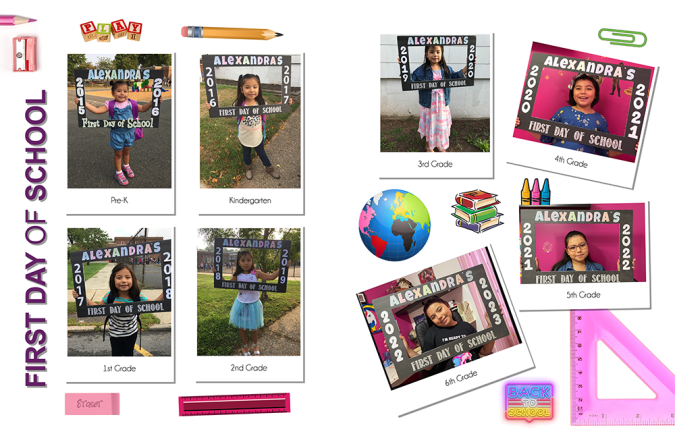
Why We Loved It
First of all, kudos to Ms. Moya for keeping the frame year after year. "That in itself is worthy of an award," one judge said. "I love the timeline," said another. The parents on the panel enjoyed seeing Alexandra grow, and the designers called out the consistent use of the caption block. It's clean and emotive.
Finalist: Jenny Errante From Phoenix, AZ
Errantes two daughters perform in their home state and beyond. She created a set of custom pages for each to call out their unique talents (for the sake of the contest, we chose older sister Evie's). "Both the colors and smokey overlay are representative of a stage atmosphere with a spotlight," Errante said.
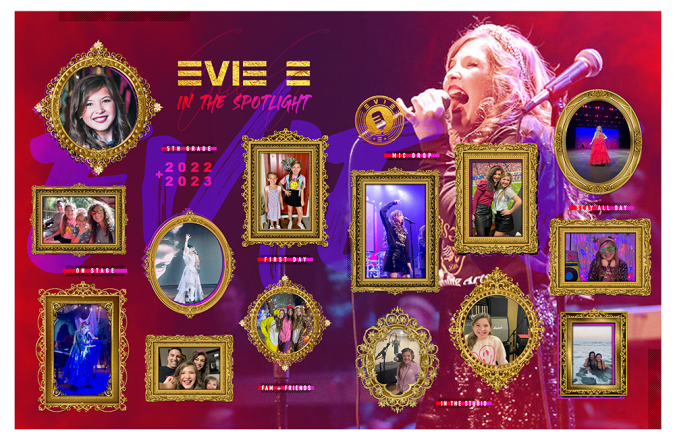
Why We Loved It
From color grading on the main image and the shaded Evie across the photo to the action shots within the gilded frames, this made our designers giddy with detail. "I love the background," one judge said. Each image supported the "spotlight" concept and Errante's daughter's love for the arts. (We're thinking creativity runs in the family.)
Finalist: Brooke Turner From Justin, Texas
Because her daughter loves bright colors, Turner created this kindergarten highlight spread with that in mind.
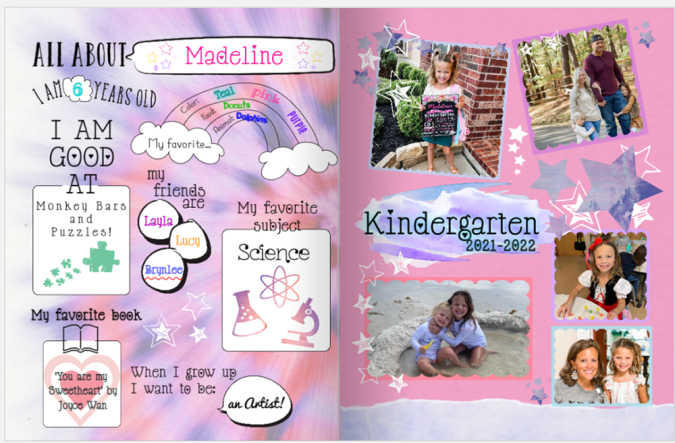
Why We Loved It
One of our judges said, "It's a kindergarten girl's dream." Turner's use of color and modification of Treering's About Me templates demonstrate an understanding of design theory. She kept to a softer palette and used the watercolor texture from a variety of Treering's themes to create this spread.
Finalist: Elyce Shorb From San Diego, CA
As a long-time Treering parent (these are her seventh set of custom pages), Shorb said custom pages "help my daughters share with their peers many activities and events that may otherwise have gone unnoticed." She uses them to highlight the twins' "personal highlights that showcase their extracurricular activities each year that include birthday celebrations, sports, Halloween costumes, field trips, school dances, and even family vacations."

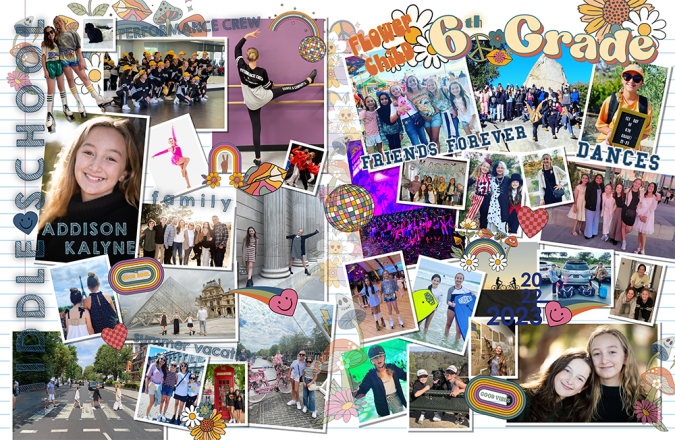
Why We Loved Them
Initially, we did a double take. Of all the parents who submitted multiple spreads, we decided to place both in the finals because Shorb honored her twin daughters with their individual interests and achievements using the same layout. And when we took a second look, we noticed the minor changes in the graphics: orange vs. pink heart, green vs. blue text overlay, etc.
"These two spreads remind me of what a girl at their age might have hanging up on their bedroom wall, photos of memories pinned up with pushpins or taped around the outer edge of a mirror," a judge said. "It brought a little nostalgia to my mind."
Finalist: Bhavika Lodhia From Aliso Viejo, CA
"We wanted to express his creativity, show off his dancing, acting, and athletic skills, and display his kindness and love towards families, friends and animals," said Lodhia.
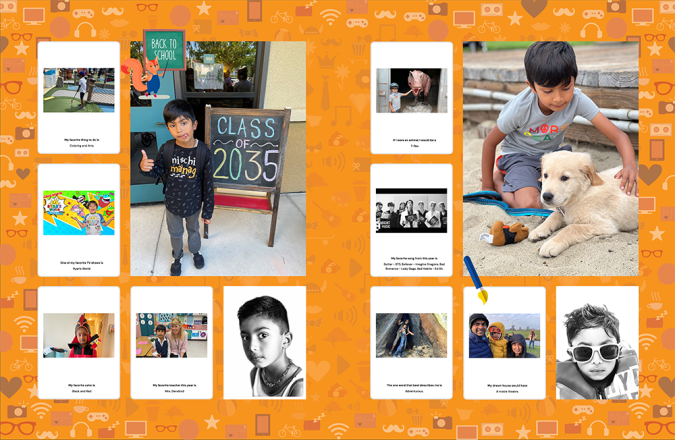
Why We Loved It
Using a combination of Treering memories and photos, Lodhia captured a moment in time by giving her son literal snapshots into his personal history and interests. We're hoping Lodhia re-creates the dog pic for comparison in a few years.
Finalist: Ashley Diamond From Moses Lake, WA
First grade was a pivotal year for Ollie. Diamond said, "He broke out of his shell and made some wonderful friends and even joined a few sports teams."
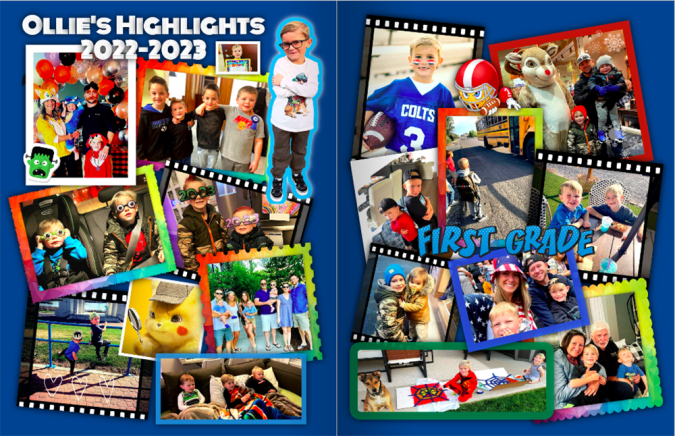
Why We Loved It
As you saw from our design contest, scrapbook-style design is trending. We love the frames, and while the rainbow ombre could get out of hand, Diamond balanced it with the film strip and solid color frames. This is truly a collection of highlights in Ollie's year.

Winners of the 2023 editor's choice design contest
For three years now, the Treering Design Contest is a spring tradition: advisers and student editors across the US and Canada enter their favorite spreads of the year. This time, we took the vote to the people: after selecting ten finalists from over 300 entries, the world shared the love and likes via the official Treering Facebook and Instagram pages. All ten finalists earned three free yearbooks and $50 from Amazon. The grand prize winner earned 10 free yearbooks and a $500 Amazon gift card.
"It is amazing to see the passion our editors have and inspiring to know we provide a platform for them to capture and share their memories."
Bobby Hernandez, Treering Head of Growth
On behalf of the judges—a team of editors, publishing professionals, graphic designers, and moms—who appreciate every person who submitted their stories and spreads, thank you for providing inspiration.
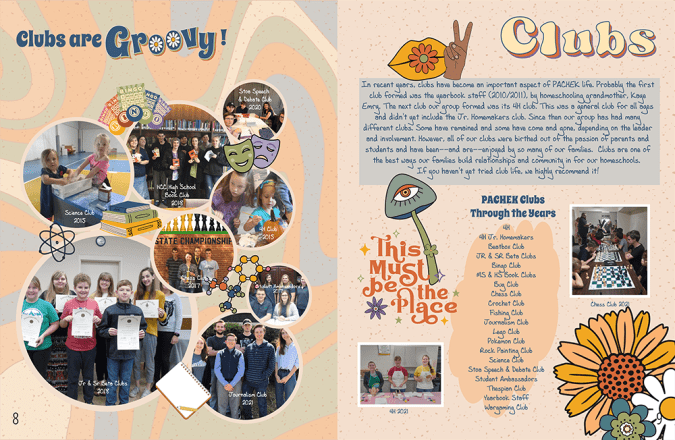
Grand Prize Winner: PACHEK, Hopkinsville, KY
Celebrating the 30th anniversary of their western Kentucky homeschool support group's formation, PACHEK used "photos from previous years related to [each section], along with a paragraph with a little bit of group history," parent and yearbook volunteer Lora Farrell said.
Why It's a Winner
Using Treering's "Groovy" theme, PACHEK captured the past and present. There is an obvious hierarchy with the headlines and graphics. We loved that every photo includes an identifying caption. One judge said, "This spread shows how easy it is to use Treering graphics and layouts. You can still edit them to make them personable to your audience."
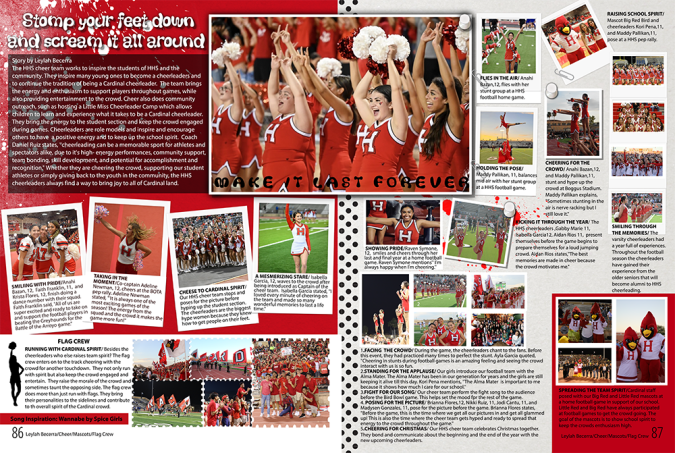
2nd Place Winner: Harlingen High School, Harlingen, TX
Because songs are a tool and reflect moments in time, the team at Harlingen High School used song titles to shape and guide headlines and subheadlines. "They want the students to flip through the yearbook and be able to read but at the same time experience songs that will remind them of the good moments today which become the memories of our past that we will share in the future," adviser Zeila Rodriguez said.
Why It's a Winner
Beyond the music (see what we did there?), visually this spread oozes memories. It is laid out much like someone would save clipping and highlights on a corkboard. "[The hierarchy] draws the reader in," a judge said, "There is the main photo and you are able to easily follow the flow of the spread." Every photo tells a story and has an expanded caption to teach us what we didn't see. Another judge said, "You can almost feel the music as you read through the stories on this spread."
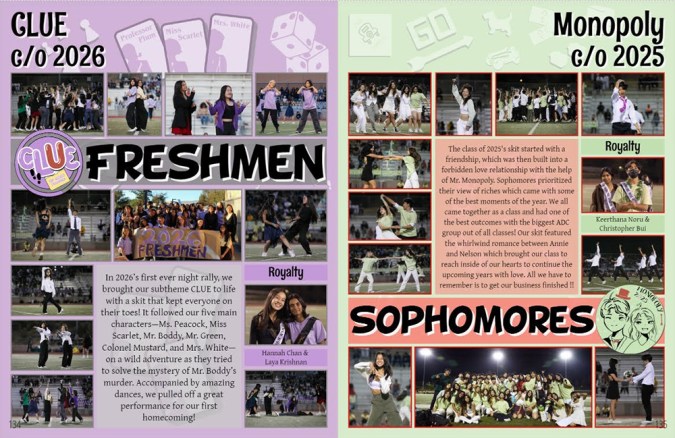
Third Place Winner: Jackson Tong, Evergreen Valley High School, San Jose, CA
When you hear all that Evergreen Valley High School does for its fall homecoming jamboree, it could be overwhelming. "During this season, student leaders create and host a large night rally show with numerous club and class performances, spirit days, dances, and athletic activities," student editor Jackon Tong said. They use multiple spreads to cover the week inspired by classic board games.
Why It's a Winner
Tong said, "Many students from all social backgrounds come together to celebrate our school spirit," and we loved that this spread highlights the diverse activities and groups involved with homecoming. The 24 photos are organized and we applaud the use of color to group elements visually. One of the judges said, "They did a fantastic job representing the lower classman at their school."
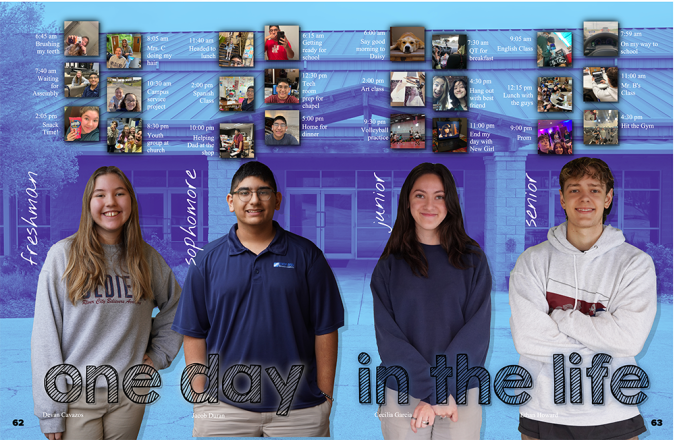
Finalist: River City Believers Academy, Selma, TX
Authenticity is the goal of the team at River City Believers Academy. Throughout the book, they wanted to showcase how they "do 'real life'" on campus and off. As a K-12 private, church school, they actively seek new enrollments and use the yearbook to help. "When people stop by the office they always like to look through our books, as they are a great indicator of the culture, love, and commitment we have for our school," adviser Carmen Garcia said.
Why It's a Winner
This is a well-executed idea to cover four more students in the book. We loved the combination of user-submitted snapshots up top with professional portraits. It shows how everyone has a story to tell. This spread could be replicated as a module on a portrait page or expanded to be a theme covering athletes, artists, administration, and academics.

Finalist: East Stroudsburg High School North, Dingmans Ferry, PA
Despite being what adviser Keisha Agard-Thomassine calls a "quirky bunch of souls who meet atop one of the beautiful Pocono Mountains in northeast Pennsylvania," the Timberwolf spirit is evident across each spread in the East Stroudsburg High School North yearbook. "We are brimming with talent and pride and our Carolina blue flickers through our halls, walls, sneakers, and Crocs," Agard-Thomassine said.
Why It's a Winner
From the color grading of the photos to the field hockey stick and ball frames in which the collages sit, this is exquisite. The judges also called out the lowered visibility of the background image as a tool to make the photos pop. The photos demonstrate intensity and action and the large cut-out looks to the right-facing page, directing the eye flow.
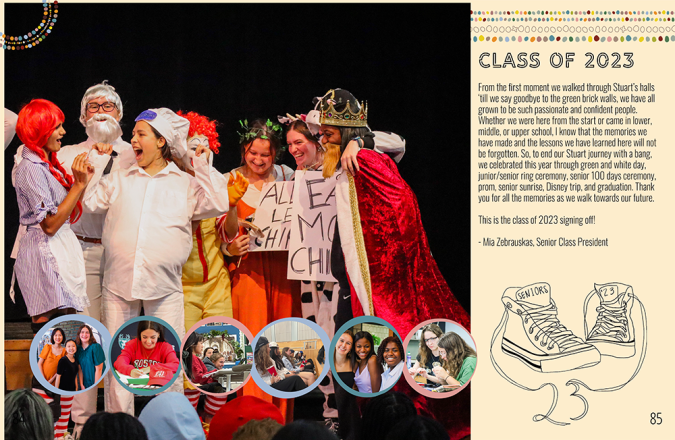
Finalist: Stuart Country Day School, Princeton, NJ
"Shoes tell a story," student editor Lucy Simon said. She and her co-editor have attended K-12 Stuart Country Day School for most of their lives. "A person's shoes are a unique expression of their journey and personality." The shoe motif and vibrant colors express the energy and excitement of the journey.
Why It's a Winner
When this spread came up in judging it was a hold-your-breath moment. The general intake of air preceded an enthusiastic discussion of the balance of the design and boldness of color. "I love the shoe graphic added on this page," said one judge after reading their story.
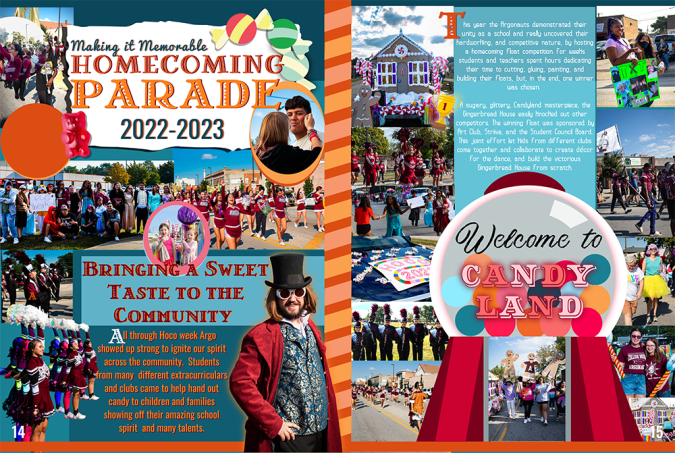
Finalist: Argo Community High School, Summit, IL
The sub-headline says, "Making it Memorable" and the team at Argo did just that. Traditionally, they've used a school color palette. "While we do have elements of the traditional maroon, we choose a wider palette to make this year different," adviser Lisa Garrett said. This diversion further strengthens their 2022-2023 yearbook theme, "Make Your Moment." Garrett said, "When you chose to collaborate, excel, succeed, and participate you are making memorable moments."
Why It's a Winner
Homecoming is one of those events that is larger than life on a high school campus. This spread captured what a treat it was for their school to have a week where their spirit went beyond the school walls (and pages). "This spread encompasses the meaning of school spirit and having community support," a judge said. Another said, she "loved use of the gumball machine."

Finalist: Wayne High School, Huber Heights, OH
At the end of their junior year, Wayne students select two of their own to be community ambassadors for the school. Using a movie theme for the school's 75th anniversary of yearbook creation, each spread has cinematic flair. "One of our editors created this spread, and we love the little touches like the red [ampersand] throughout," adviser Beth Stacy said. "His inspiration was the movie 'Mr. and Mrs. Smith.'"
Why It's a Winner
We agree with Stacy: the pop of color is a small detail with a large impact on the design. This spread has balance in terms of copy, photos, and graphic elements. "The story behind this spread is fantastic. They did a great job using Treering's design features to tell the story with these photos," the judges said.
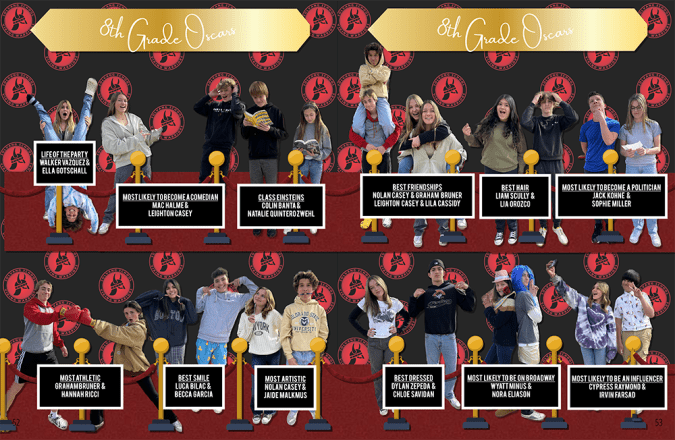
Finalist: Solvang School, Solvang, CA
Because the yearbook team used Treering's "Watching" theme, they "created a red carpet-style spread for our 8th-grade superlatives," adviser Alyssa Spanier said.
Why It's a Winner
The designers on the judging panel deemed the maximalism of this spread to be a show-stopper. It captured both the school spirit with the tiled mascot as well as the theme. What an energetic send-off for these students to high school.
"You have to enjoy the school spirit shown here," one judge said.

Finalist: Classical Conversations - South Bend Campus, South Bend, IN
"This design was inspired by one of my favorite design styles: Mid-Century Modern/Bauhaus," parent editor Carolyn Baltazar said. "I love how impactful and bold it is while still remaining very true to its extremely simple elements."
Why It's a Winner
Since over 1200 Classical Conversations communities publish yearbooks with Treering annually, this is one spread that can easily be replicated in each book.
Runners Up
If the top 10 weren't enough yearbook inspiration, check out this gallery of runners-up from Academy of Innovation, Central Middle School, Northern High School, Northampton High School, McKinley Steam Academy, Rawlins High School, and Wheeler Elementary School.
Honorable Mentions
Actis Jr. High
Baumholder Middle High School
Berean Academy
Cal Aero Elementary Yearbook
Camp Wekeela
Changemaker High School
Chapel Hill Christian Academy
Classical Conversations - Central Lakeland, FL
Classical Conversations - Dallas, TX
Classical Conversations - Greensboro, NC
Community Baptist Christian School
Council Jr./Sr. High School
Creative Learning Christian School
Dalhart High School
Deep Waters Academy
Doherty Memorial High School
Dumas High School
Eagle Ridge School District #36
Early College Academy High School
Founders Classical Academy of Flower Mound
Fox Meadow
Franklin Elementary
Freedom High School
Fulton Science Academy
George F. Baker High School
Glennallen High School
Grandview Hills Elementary
Haines Borough School District
Harrison Lane Elementary
Henderson International School
Hermosa Middle School
Hazel Point Intermediate
Heron Heights Elementary School
Lakeside Christian School
Landmarkhs.org
The Learning Connection Co-op
Lennox Middle School
Lois Lenski Elementary
Magnolia Science Academy Santa Ana
Mark Twain Elementary School
Mary Blount Elementary
MaST II Community Charter (Tacony Campus)
Mt. Eden High School
North Elementary School
Niles McKinley High School
Oakville MS/HS
Ocean Shore School
Orangeburg Christian Academy
Pelham High School
Phoebe School of Presidency
Piper School
Prairie Lea School
Queen's Grant High School
Radcliff Elementary
La Reina High School
Rita Ledesma Elementary School
Roaring Brook School
Sacred Heart Catholic School
Seabrook Elementary School
SEED School of Miami
Springton Manor Elementary School
Sycamore Creek Elementary
Tech High School
West Valley High School
WR Odell Elementary

Yearbook design hierarchy
Design hierarchy of a yearbook spread refers to the arrangement of elements on a page in order of importance, with the most important element drawing immediate attention and receiving support from secondary and tertiary elements. When you apply these design principles, you are taking your readers on a journey across each yearbook spread by telling them where to begin and where to exit each spread through visual cues. Sound complicated? No worries, we'll break it down below.
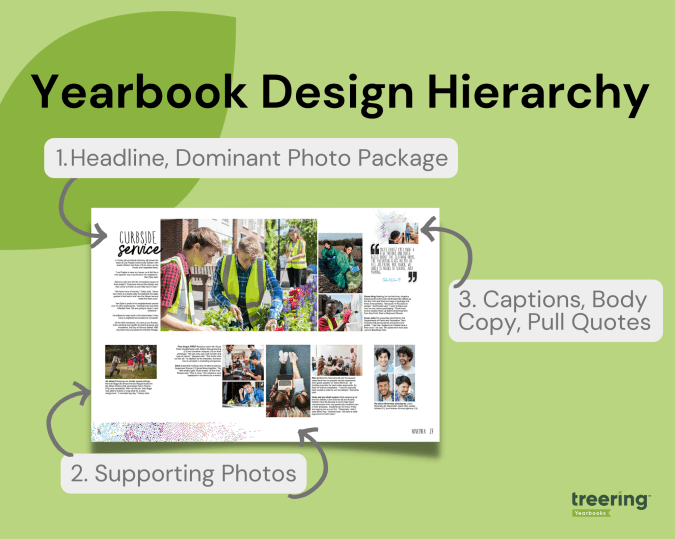
Dominant Elements
Think, "We're #1!" The dominant elements in yearbook hierarchy are headlines, the dominant photo package, and a subheadline. The dominant elements are just that: they dominate the most real estate on the spread. It's from them the rest of the content builds.
Headline
The headline is the most important element on a page and serves as a brief content summary. It should be attention-grabbing and provide an overview of the page's content.
Dominant Photo
This is self-explanatory: the largest photo on the spread is the dominant one. It draws the eye. It connects to the headline. It sets the tone for the entire spread. The best dominant photos are storytelling or action shots.
Subhead
The subhead is a secondary headline that provides more detail and context to the main headline. It can also be used to break up yearbook spreads into smaller sections, or modules.
Secondary Elements
Your secondary elements build from your dominant ones. Think of them as a great ensemble cast.
Photos
For most, photographs are the most important part of a yearbook. The individual images and their positioning on the spread can help further illustrate the page topic and make the page more visually appealing.
Quick tips:
- Eyes should look toward the center of the spread, not off the page
- Similar photos should be in proximity to one another
Tertiary Design Elements
If your headline and photographs did their job, readers will swoop in to enjoy your captions, copy, and extras.
Captions
These beauties provide context and information about the photos on a page, therefore they should be near their respective photograph. While they should be concise and well-written, it's easy to get cliche: "Tomás Bernal (7) enjoys his lunch." Start with the 5 Ws and then up your caption game by adding expanded captions.
Body Copy or Yearbook Stories
This is the main text on a page and provides the details and information about the subject being covered. It should be well-written, easy to read, and relevant to the headline and dominant topic of the spread. Often, when a dominant photo is of the storytelling variety, it will complement it and further explain its significance.
Sometimes, an "ident caption" will suffice. This is a list of names of students pictured, including their grade. In the middle school book below, the yearbook team used ident captions to outline the event program from the annual fundraiser.

Pull Quotes
Pull quotes are quotes from the body copy that are set off visually and used to highlight important or interesting information or one-off quotes from a student. They have both visual and verbal significance because they highlight the spread's topic with a unique POV. They can also add to the overall theme by bringing in theme elements.
Graphics and Design Elements
Like everything in yearbook design hierarchy, graphics and design elements, such as borders, backgrounds, and page numbers should be intentional. It's easy to get out of hand with Treering's graphics library, so that's why our design team cultivated 300-ish fully editable themes and color palettes for you. The purpose is to make the page more visually appealing and easier to navigate while telling the story of your year.


The hierarchy of a yearbook spread can vary depending on the page's content, and following this basic structure can help ensure that the page is well-organized and easy to read. If you're teaching yearbook or leading a club, use it
- As a checklist for students who are beginning to design
- For a scavenger hunt to see who can identify elements on a spread in a magazine or another school's yearbook
- To build your program by strengthening yearbook hierarchy in each design

Six ideas to fill pages
Page count can be a dirty word in the yearbook industry. It’s how we compare programs or evaluate pricing. It's also how we wow our readers. Peppering in showstopper spreads breaks up the monotony of photo collages, portraits, and team photos. These pages also fill your yearbook with even more personal stories and unique-to-this-year happenings. (And if we're being honest, these last-minute ideas can help you increase coverage with ease.)
1. Interactive Pages
Drop-in yearbook spreads, such as about me pages make it effortless to complete the year's story. You can customize the questions and prompts on these fully editable yearbook templates and give students even more space to share their POV on the year. If you don't have a spread to fill, consider adding a sidebar so students can react to campus happenings.
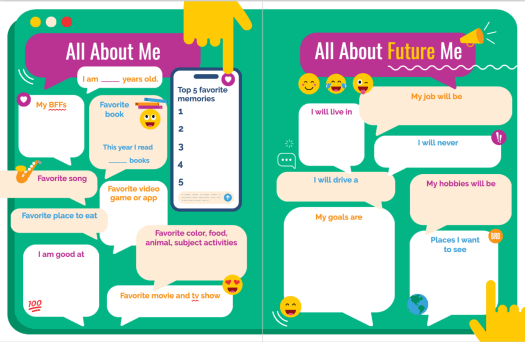
2. Spirit Quiz
When Sequoia High School had over half a page to fill in their junior section, they added a teen magazine-style quiz. This spirit self-assessment featured eight additional students plus the school mascot while showing off what is uniquely Panther programming.
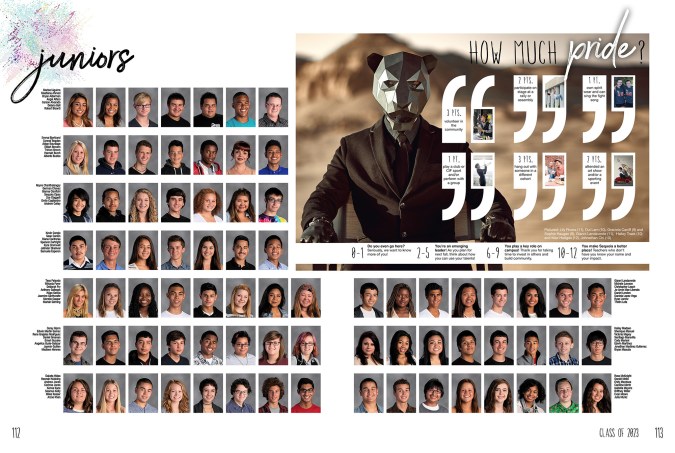
Make it Your Own
For your spirit quiz, determine which activities and behaviors define your student body and assign a point value. For example:
- Owning spirit wear +1
- Participating in a club +2
- Attending a musical or a sporting event +3
- Knowing the lyrics to the fight song or alma mater +3
- Serving the community+3
Use the scoring to affirm your community, even if it's a one or two. A simple "we want to know you more" will go far for students trying to find their way.
3. Then and Now
We’ll save the yearbook-as-public-record soapbox for another blog. Know this: anniversary years are a great time to reflect on where your school community has been and where you are headed. Schools also use building projects, campus splits, and expansion projects to add reflective photos and copy to their yearbook pages. Does this sound overwhelming? A show-stopper spread in your theme copy or your people section is all you need.
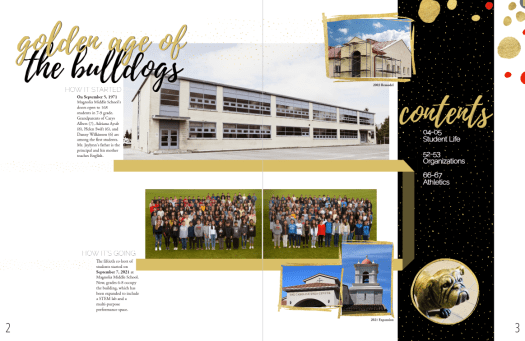
In addition to featuring changes in the building, you can write about or share photographs from
- Teachers and coaches who are alumni
- Current students of alumni
- Famous alumni (ICYMI: alumni are a huge resource)
- The local historical society
- Past yearbooks
- Blueprints
4. Pet Spread
If you’re new to crowdsourcing, or in need of additional coverage, start with a pet spread. If we’ve learned anything from #caturday and #dogsofinstagram, it’s that sharing pet photos brings us joy and is a natural part of our culture. Case in point, when our design team asked the Treering staff to submit photos of their children and pets to use in sample spreads, the latter had nearly twice the submissions.
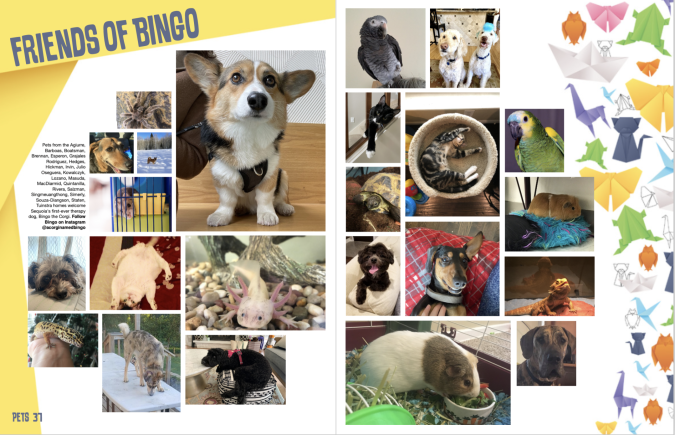
When your students crack their yearbooks open in five or 15 years, the sight of their furry, feathered, or scaly friend beside their artwork and activities truly captures a moment in time.
5. Art Showcase Pages
Student contributions extend beyond the field, club meetings, and stage. Those creative moments in the studio or during classroom art time belong on your yearbook pages. Also, like a pet spread, an art spread is a way to include those camera-shy students.
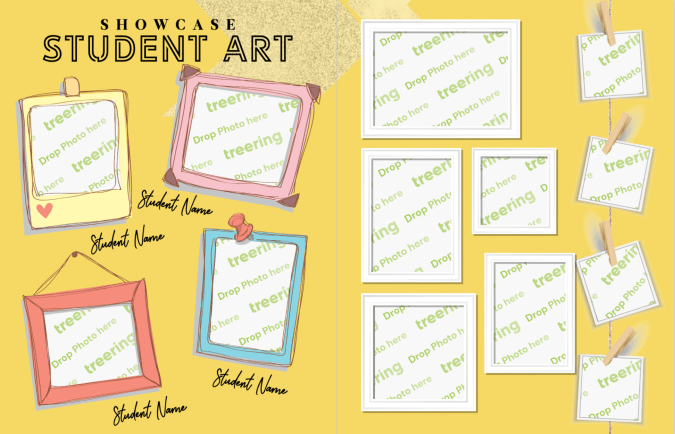
6. Fashion Page
Expression isn’t limited to canvas and ink: Yearbook Hero Grace Montemar said her school included a fashion spread because it “allowed Yearbook Club to spotlight classmates from various grades whose fashion sense stood out from the crowd.” Featured students expressed their style and their inspiration with interviews.

We love how this school asked students from each grade level to come to the photoshoot in a white shirt and jeans.
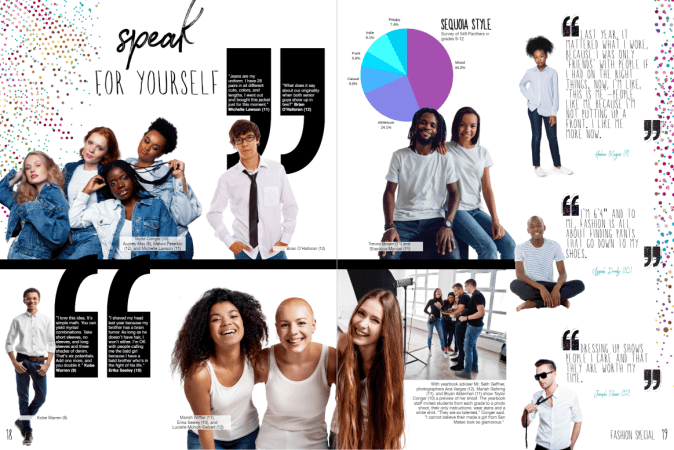
Do you have more easy ideas to fill pages? Share them via social and tag us!
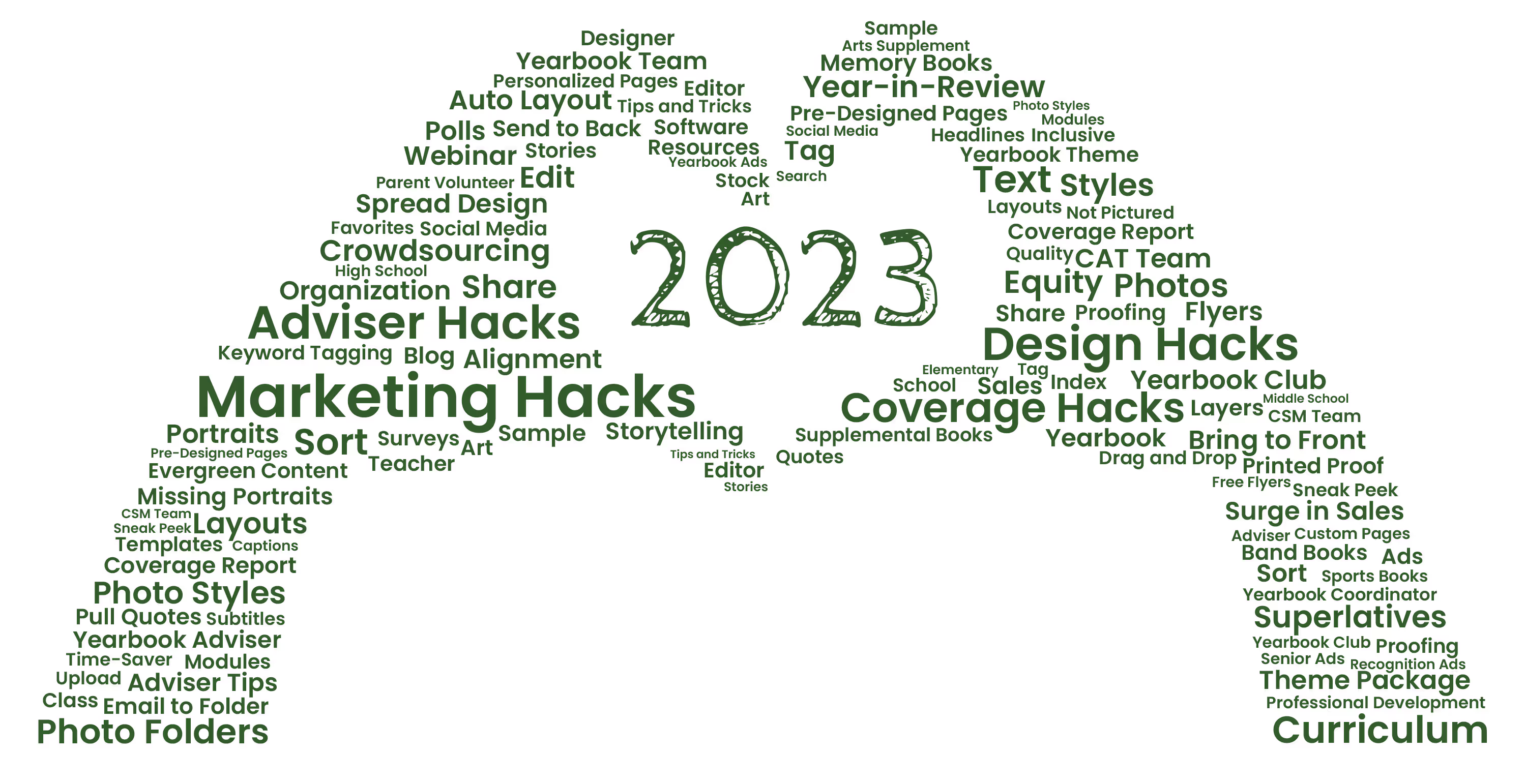
23 yearbook hacks for 2023
Forget resolutions, it's time to get to work. Our staff brainstormed the top yearbook hacks you can use at any stage in the yearbook creation process and packed this blog with videos, how-tos, and examples. Use the quick links below if you need to jump to a specific area.
Yearbook Design Hacks
Designing a yearbook is much more than just putting pictures on pages. Intentionality, storytelling, and branding are included. The following time- and sanity-savers will help you progress in your role as editor, adviser, coordinator, or yearbook fan girl.
1. Auto Layout
What if you could just drag the photos you want to use on a spread and they would magically be organized and re-sized? Voilà!
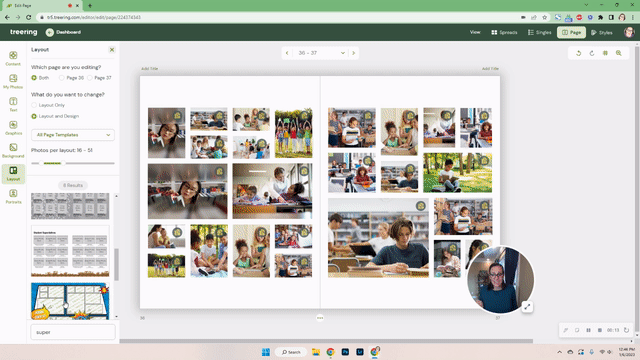
The best part? Everything is still fully editable, so if you need a starting point, you can continue to build your spreads with more photos and text, swap our images, and change the color of the elements.
2. Color Picker
You can pull the exact color from any picture to add to your design. This builds the yearbook’s visual cohesiveness because you can pull from photos or graphics to create your custom palette.
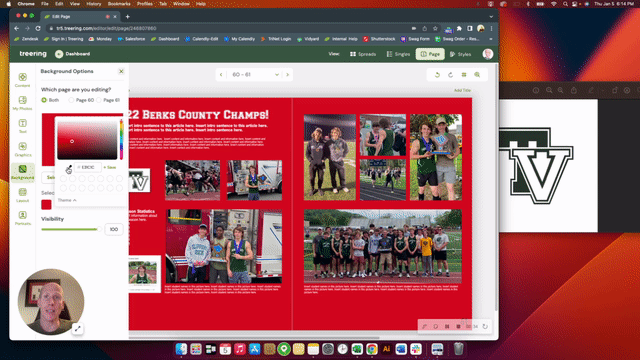
3. Layers in Design
Up your design by using layers to arrange photos, images, and text. In the examples below, you'll see graphic elements used as photo frames (movie night spread) and editable shapes used to organize content (table of contents). Using the forward and background tools in the options panel can help you arrange elements.
4. Custom Pages
Schools are used to offering senior ads as a way to congratulate students. Treering schools take it a step further and allow every family to tell their story with two free custom pages (and the option to add even more).
5. Missing Portrait Hack
"Picture day is the easiest day of the year," said no adviser ever. As hard as we work to make it a flawless experience and to capture every student and staff member, perfect attendance is out of our control. One way we love to see people included in their respective sections is by flowing them in with this spirited touch.
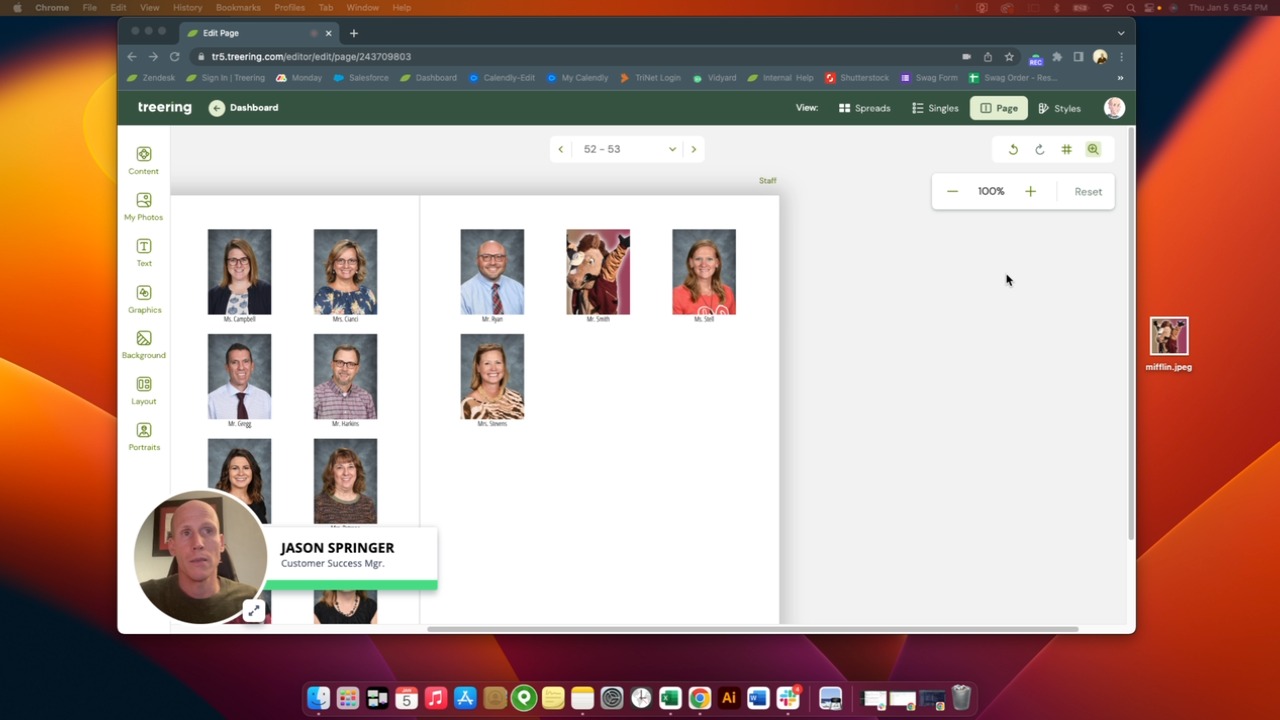
6. Advanced Portrait Settings
Another hack for your people section is included with the advanced portrait settings. Subtitles are a simple way to add marks of distinction such as student activities and honors as well as staff department or job titles. Other advanced portrait settings include spacing and sizing options.
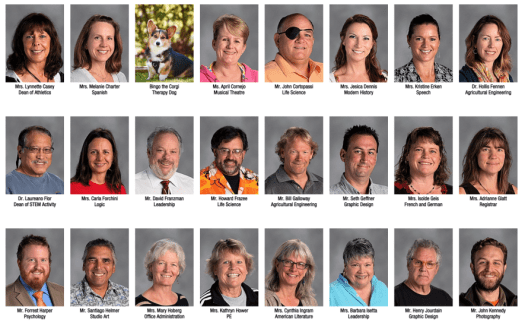
7. The Magical Shift Key
Shift your process for aligning and rotating objects.
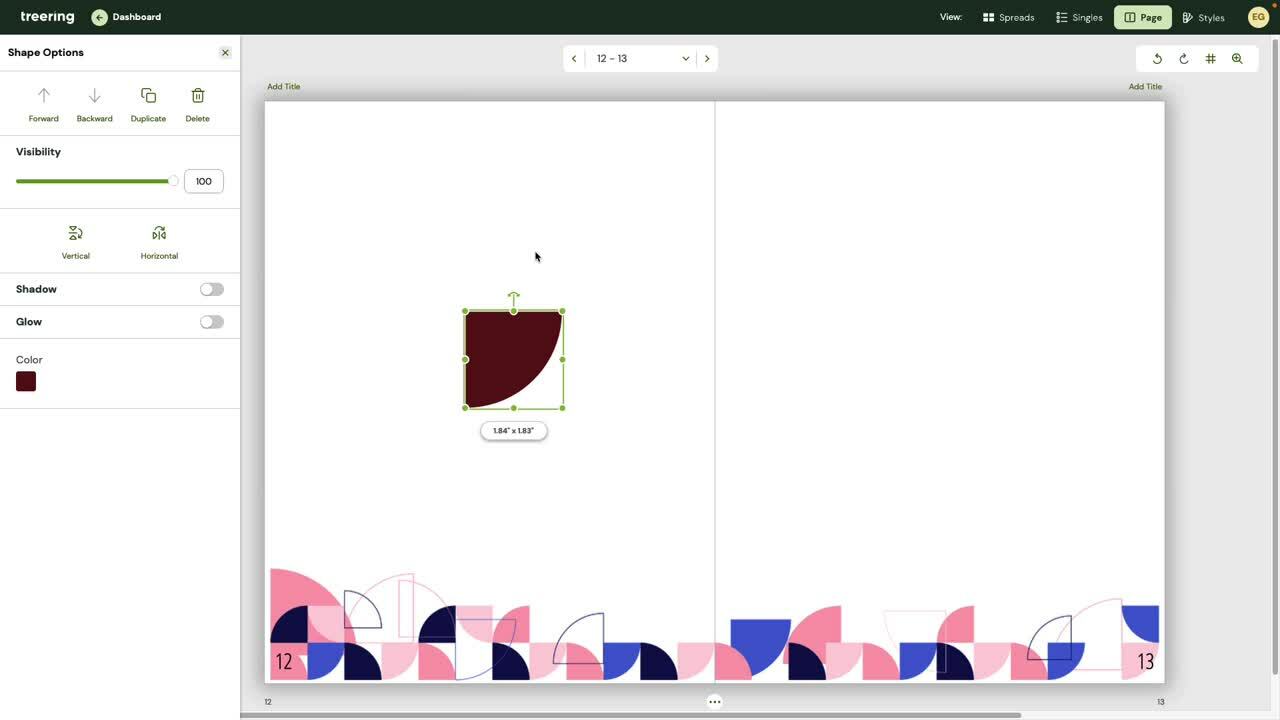
8. Printed Proof
A printed proof is an exact copy of your yearbook, and every school gets one free. Use your printed proof to
- Check the placement of cover art
- Assess the readability of fonts, especially the names on your portrait pages
- Show off your amazing work (more on this in the marketing section)
9. Picking Favorites—it's OK!
"Liking" graphics, backgrounds, and photos makes it easier to find them to add to yearbook spreads. To use your hand-picked collection in your book, filter by "My Likes" and "Team Likes" in the drop-down.

10. Pre-Designed Pages
Annually, Treering publishes elementary and middle/high school "Year in Review" and "Best of the Year" Pre-Designed yearbook spreads. These spreads include noteworthy highlights from pop culture and current events, and like all things Treering, these pages are editable so you can choose to replace the content with your own. Some communities prefer school or local election news, campus trends, or athletic records. Pre-Designed pages which include mention of our philanthropic partner, Sandy Hook Promise, are also available as well as about me, art gallery, and puzzle pages.
Get More People in the Yearbook
The best practice for yearbook coverage is to ensure each student is in the yearbook three times. Think one photo in each section: portrait, classroom, and activity.
11. Crowdsourcing Features
Treering’s crowdsourcing tools include integrations with Facebook, Instagram, and Google Drive as well as shared photo folders. Teachers, parents, and students can email photographs from their devices directly to event folders in your school account.
According to adviser Lauren Casteen, Yearbook Hero and leader of Treering’s Teaching Yearbook cohort, there are four reasons to crowdsource content:
- Equity: if you want your book to look like your school, your school needs to help you build your book.
- People are already familiar with documenting and sharing their lives via social media—it’s an easy next step.
- Your yearbook staff can’t be everywhere all the time.
- Less work for you! (This is our favorite.)
12. Monitoring Coverage
A big question we hear is, "Why would you want to tag student names when we're not doing an index?" Since our job as advisers is to cover all the students on campus, tagging is one way to track how many times students appear in the yearbook. It also helps you find out who is missing from your pages and craft strategies to include them.
13. Keyword Tagging
By using keywords such as event names and topics (e.g. AP Lit), your search just became that much more powerful, and the English folder less intimidating to navigate.
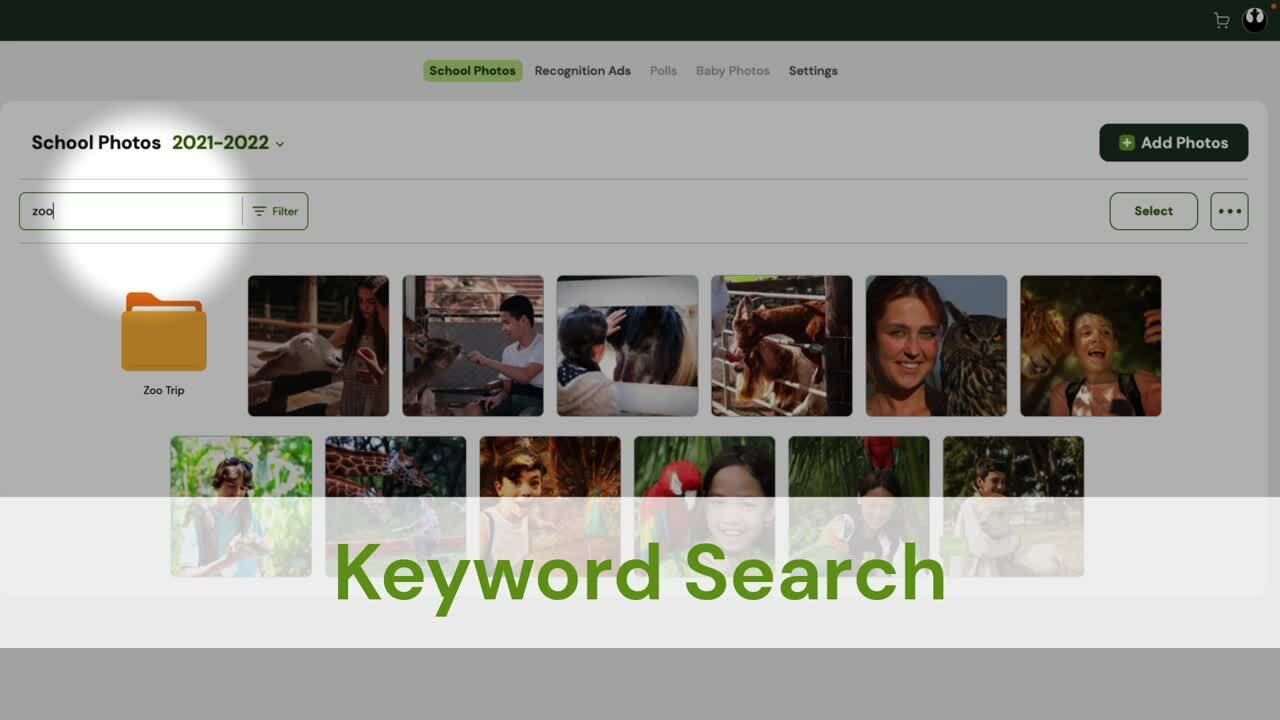
14. Find Carmen San Diego
Tagging by student name helps you easily find students within your web of folders.
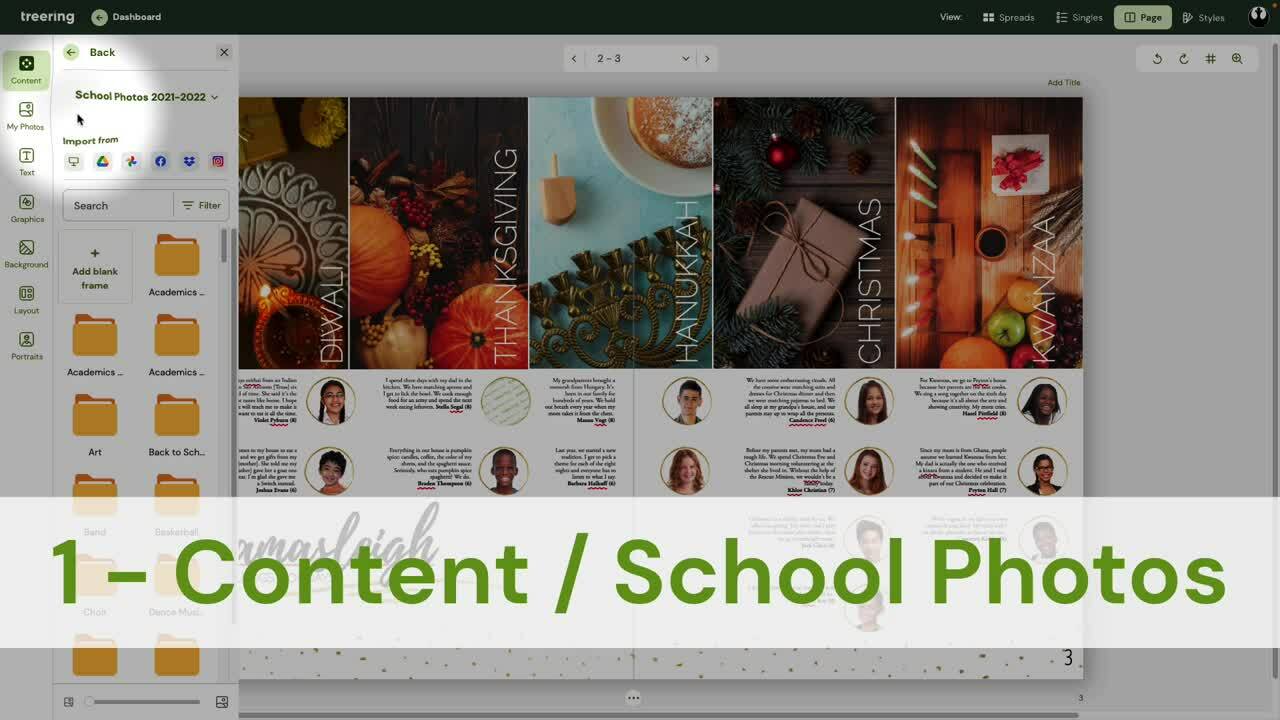
15. Polls
Create polls to give a snapshot of the student body's preferences. Treering's software even makes the graphs for you. Expand on this or that-style questions or multiple choice ones by interviewing a respondent for more detail. You may be surprised why your star soccer player is a cat dad.
Marketing Tips
The second semester is when we see surges in book sales. Here are some hacks to get more yearbooks in more hands.
16. Free Yearbook Flyers
The price is right. So is the message.
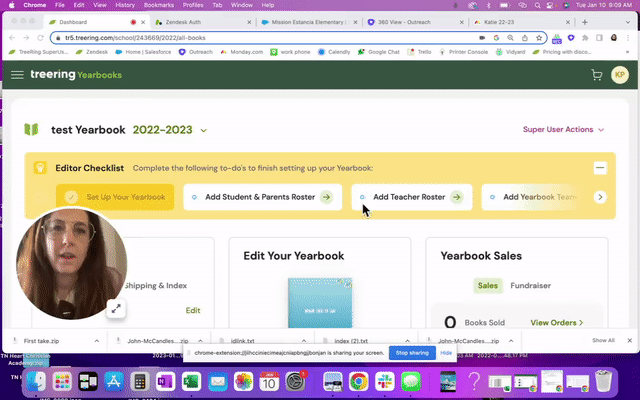
17. Use Your Printed Proof as Social Proof
Social proof is one way you can positively encourage others to support your program by buying a yearbook.
- Show students, teachers, and parents how you are using the photos they submit by posting a PDF proof with their snaps in use
- Share sneak peeks
- Photograph your printed proof around campus as if it were a student (tag us!)
- Video your yearbook team swooning over their work
Hacks for Yearbook Advisers
All of the above definitely apply to yearbook advisers and coordinators, and here are few extras because you are our people.
18. Free Webinars: Yearbook Club
A yearbook adviser PLC? Live yearbook training? Technology pro-grow? However you want to sell it to your admin, we have it. And it’s free.
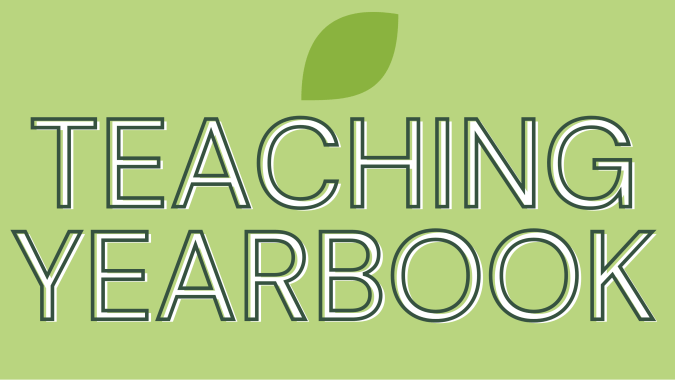
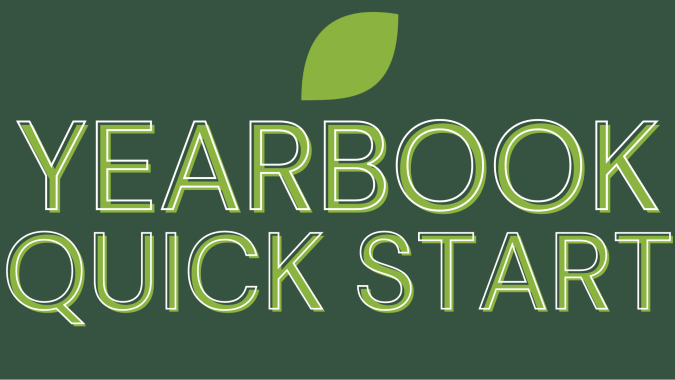

19. Styles
By establishing photo and text styles early on, you create a cohesive look for your yearbook. Because the font library continues to grow, it's nice to set some limits, especially with emerging designers!
20. Portrait Proofing with PDFs
Printing PDF proofs from the editor dashboard as soon as you get your portraits flowed is one quick way to ensure accuracy. Distribute them to the office staff and classroom or homeroom teachers for a double and triple check.
21. A List of Evergreen Content
Evergreen content for yearbooks is a collection of interview questions, infographic topics, and story ideas that can be used throughout the year. While we want to have a yearbook that reflects the current year and trends, having a timeless collection keeps your students working on interviews and photography and provides material to fill in on portrait pages, sports sections, and even in the index.
22. Supplemental Books
Sometimes club sports, special events, and alumni need a little extra. You can still attach a fundraiser, take advantage of our free design software, and enjoy all the other perks of making a Treering book: no minimums and a three-week turnaround from the day you submit.
Treering’s printed books for family reunions, church or neighborhood directories, scout troops, sport associations (rodeo, mountain bike, cheerleading, gymnastics), 4-H, school auctions, cookbooks, performing arts studios, first responders, and more.
23. Yearbook Hack Central: Treering Blog
(Shameless, we know!) We're glad you're here and hope you find more yearbook hacks by searching the blog or signing up for notifications when we post new content.
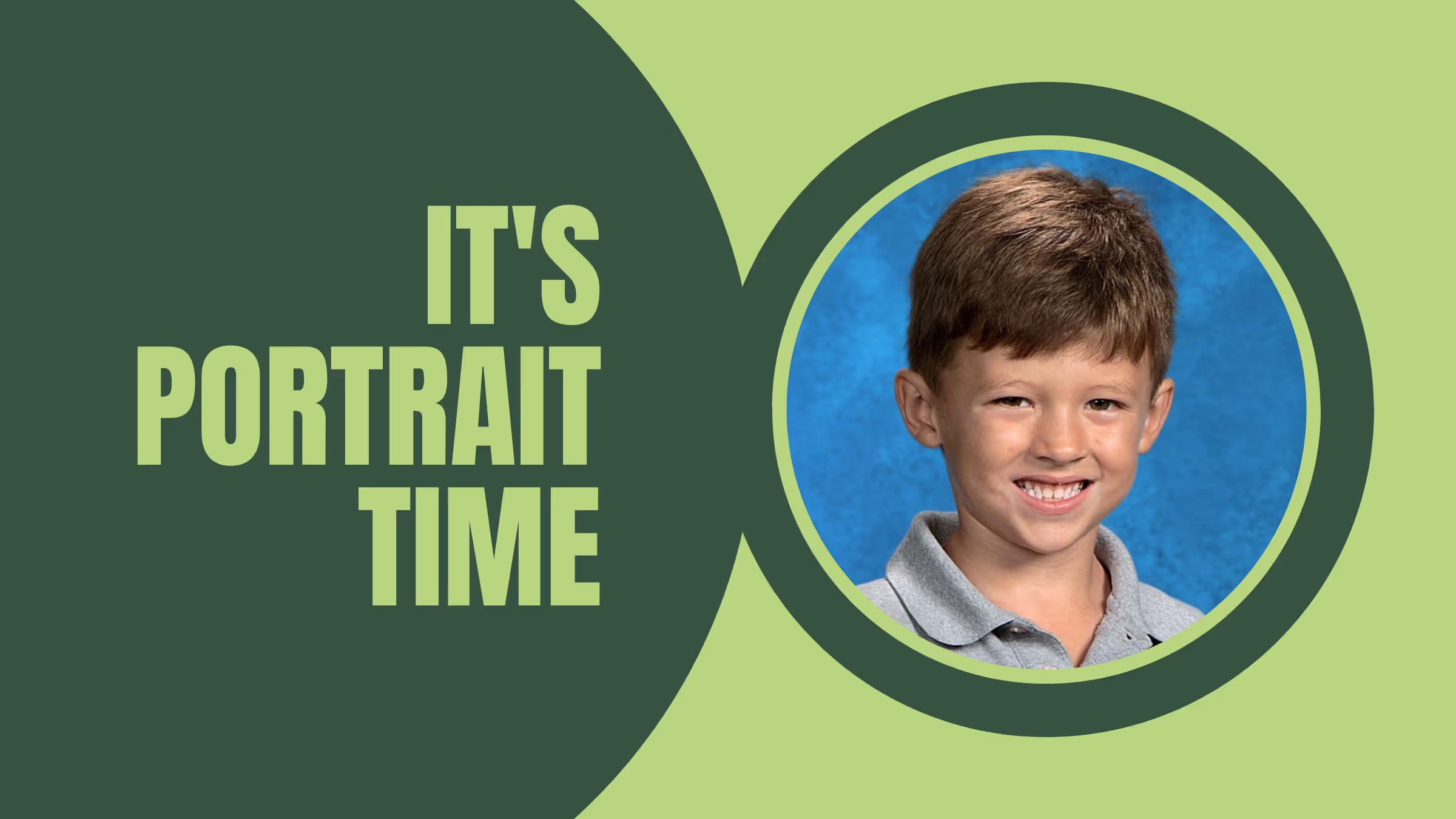
Portrait perfection for your yearbook
Yearbook portraits comprise up to 40% of your book. Pause and contemplate that for a sec: row after row of awkward head tilts and half smiles with the same speckled background your mom had in the 70s fill the bulk of your pages. If you want to change up your layout and use the space to add additional content and cover even more students, we have a blog for that. This one, however, will help you nail the core of your people section.
Work with Your Photographer
Treering’s portrait autoflow works with any photographer.
Tweet
If you’re not the picture day coordinator (lucky!), meet your school photographer and find out when you can expect to get access to your portraits. The two-to-three weeks between makeup day and when proofs arrive should be a part of your workflow. Spend that time prepping:
- An accurate roster
- Fall event yearbook spreads
- Poll, survey, and academics content you will incorporate in your portrait section
Extra credit: learn the how, what, and why of portrait files in the Treering Help Center.
Portrait Pages: Faster Than a Cup of Coffee?
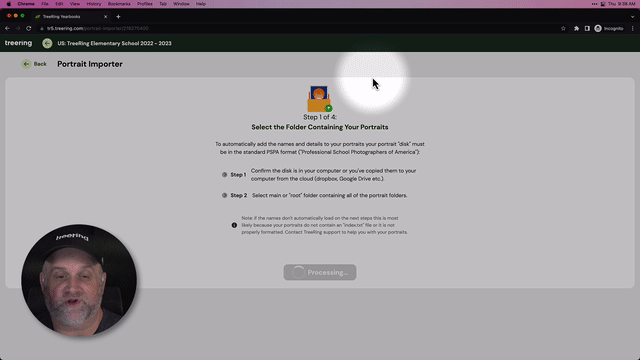
Treering’s engineers know we have a diverse group of users, so they included automation—such as portrait autoflow—in the arsenal and DIY features. Absent and new students can be flowed in after the fact, and your portrait pages will automatically re-alphabetize. What a relief!

PDF Proofs for Portrait Pages
Editors tell us the secret to an accurate portrait section is utilizing the free PDF proofs in your editor dashboard. Some of the ways schools check names are
- Distribute proofs to classroom teachers to ensure all their class is pictured
- Post PDF proofs in the lunch room so students can sign off on their names and grades
- Work with school administration to comb through portrait proofs and match them to the school’s database
- Share PDFs proofs at a PTA/PTG/PTO meeting for parents to check (this is also a hot marketing tip)
The more eyes that you have checking the spelling of names and making sure that the photo and name match up correctly the better.

